
 US Navy 174 Fleet Destroyers (1942-44) (no list submitted).
US Navy 174 Fleet Destroyers (1942-44) (no list submitted).The Fletchers are probably the best-remembered destroyers of the USN during the second world war. Not only by numbers as they embodied the United States’s industrial might in wartime but also because they arrived soon enough to make a difference in the Pacific, with significant combat history and a total of xxx battle stars, including in Korea. 175 units were launched until 1944, based on a simplified wartime design and flush deck hull, development of the previous Benson/Gleaves but with no regard for peacetime limits, enabling much leeway in armament and upgrades. They better fit the needs of the Navy for many years. They also had an impressive career in the cold war, as DDE conversions, and under others flags for many more years. #usn #ww2 #destroyer #fletcher #usnavy
Design Genesis (1939-1940)
When WW2 broke out in September 1939, all treaties went by the windows and by that time the USN was still carrying out its peacetime destroyer program. Latest of the lineage after the Farragut class were the Bensons and the Gleaves, designed either by Gibbs & Cox from NyC and Bethlehem Steel. Albeit they were litteral clones, only distinguishable by their flat or round sided funnels, they still sported the same general outlook as their forebears, but with two funnels, five 5-in/38 guns and for the first time, two quintuple torpedo tubes banks. They became the pinnacle of USN interwar design, even though they were launched in 1939-1940. They were seen as the best possible combination on the existing tonnage limits. The naval staff still did not envisioned what could be a limit-less destroyer for their own needs.
By mid-1939 when the initial specifications for the Benson/Gleaves were laid down, the admiralty also asked for a destroyer that can generally meet greater speeds than the Benson-Gleaves. They were designed ealier on the same limited tonnage, and actually ended SMALLER in their initial drafts, than the latter. The idea was to make them more compact, but still two-funneled and perhaps sacrificing N°3 main gun to achieve this.
Started with questionnaires
First design inputs in the fall of 1939 went along initial studies by the admiralty board. A bit cutoff gtom command at sea, admiralsdid not wanted to reboot what was done already for the previous Sims class, interrogating destroyers captains in activity, at least at first. They started to Base their initial judgements from questionnaires distributed around design bureaus and the Office of the Chief of Naval Operations (CNO). Design parameters initially were strickly based on overall navy needs. There were expressed what kind of armaments were desired of the next destroyer: How many guns, torpedoes, and depth charges. Also one crucial point was to see the limit in growth possible in which the useful size will become an easy torpedo target. The consensus was that five 5 in (127 mm) dual-purpose guns and twelve torpedoes were ideal, plus 28 depth charges (with racks and throwers).
Any return to the 1,500-ton designs were also judged impossible on that base. Speed requirements stuck with realistic limits between 35 and 38 knots (65 to 70 km/h or 40 to 44 mph). All shortcomings of the previous Sims class (where captains were interrogated) came from the fact they were top-heavy, which demanded later for heavy ballasting and even reconstructions, so another consensus in that was that Fletcher design had to be widened by 18 in (46 cm) at the beam outright, independent of any other specifications. The need for a flush deck design was also controversial knowing seagoing performance will suffer, related to the WWI flush decks, but it was also recoignised the advantages of the formula, and that they would be based in the relatively calmer Pacific.
These hulls provided greater strenght, but also reduced free space, and they appeared cramped, even more than previous destroyers.
To reach the desired speed in a broader hull, due notably to the absence of a forecastle, especially forward, it was acknowledged that a radically larger powerplant was needed. To achieve 38 knots with 500-ton more, engineers calulated arpudly that they needed to jump from 50,000 shp (37,000 kW) to 60,000 shp (45,000 kW). It was difficult to just add more boilers due to the space they needed (thy would have ended with a stretched design well beyond what the Fletchers ended at. Instead, improvements were looked for existing boilers. They chosen air-encased boilers, producing steam at 600 psi (4,100 kPa) and 850 °F (450 °C), coupled with two 350 kW steam turbine, which in turn drove electrical generators plus a 100 kW emergency diesel generator.
Practically all yards went for the Babcock & Wilcox boilers and General Electric geared steam turbines, but there were variations. The boilers were larger, but the same number was kept compared to previous designs, with an increase of 10,000 shp which was quite remarkable for 1930s tech. In fact the powerplant was so successful that the follow-up Sumner/Gearing kept it, the only differences being that the latter were lenghtened by 17ft to increase oil storage (thus for more range) and worked out wavemaking resistance to reclaim speed.
The initial, ideal 6 5-in guns in twin turrets and 12 Torpedoes (which implied three quadruple banks) proved unrealistic at that stage though and when the design was refined later, the previous quintuple axial torpedo banks were kept whereas the twint turrets, still undergoind trials, were not chosen and reverted to the previous five single guns, but they were now all enclosed. AA defence was almost an afterthought and some proposed these ships be armed only with six 0.5 inches Browning liquid-cooled heavy machine guns. This evolved as the ships were later completed.
Early Design schemes, 1941 Destroyer Program
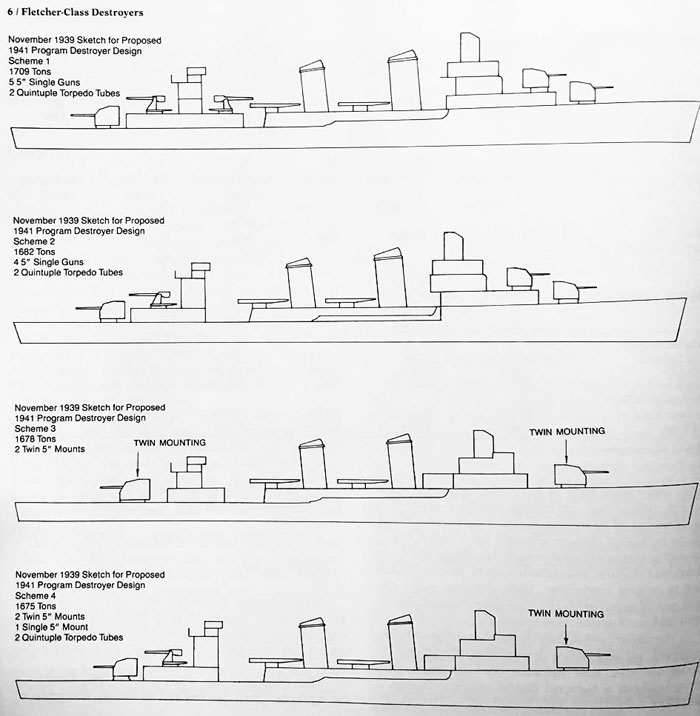
Four schemes proposed by BuShips to the Admiralty board in November 1939. The war already had started and peace limits were on paper, revocated. src “fletcher class destroyers” by Alan Raven.
Studies of these early design schemes sketches reveals how little the Fletchers (it seems the name was chosen already) would differ from the Benson/Gleaves initially, yet based on this stringent displacement versus speed contradition. First off, they still sported the forecastle configuration of their forebears, and armament varied greatly between proposals. Four initial proposals were submitted to the admiralty board in November 1939. Two were sporting single turrets, and two, for the first time, had twin turrets, in development at the time. After all this was a FY1941 programme. The first two differed by tonnage and armament: Design N°1 was very much a repeat of the previous Bensons, with four guns, two quintuple TTs, same rounded bridge, but to save weight, N°3 and 4 DP guns were unmasked (open mounts).
Standard tonnage was estimated 1,709 tonnes, versus 1,620 tonnes for the Bensons.
Design N°2 was the most compact of all, down to 1,682 tonnes, still above the Bensons, and just four main gun, sections were removed where the N°3 was. The idea was to reclaimed speed as the powerplant was unchanged.
N°3 sketch was even lighter at 1,678 tonnes but thanks to the removal of turrets and curtailing of the superstructures, the two twin turrets giving the same armament. The hull was a bit longer and speed the same as above.
N°4 sketch was lighter still at 1,675 tonnes, but managed to combine on the same hull two twin turrets and a single unmasked aft gun, to return to the 5-guns formula.
From this early serie, the first one was chosen, and from there, six new schemes were proposed by BuShips in January 1940. However at that stage it was clear that prewar treaty restrictions, not abolished by any signature of any party, were simply ignored. Free from tonnage limit, the Admiralty Board thus demanded new “stretched” variants, yet with adjustments in beam in order to maximize the width/lenght ratio on the same basic hull shape.
Final design and order (June 1941)

The naval staff this time embarked on the task of countering the Japanese “special types” truly for the first time. Until then no realistic peactime design could offer what was needed on such displacement. Now, several initial drafts pointed to a 2000+ displacement, which was a game changer. For the first time, contradictory specifications of speed, range, armament (with room for upgrades) and even some protection could be met all at once. Each time in the past engineers were asked to came up with a perfect balance but sacrifices were the rules. Destroyers that came up to that point, including the Benson-Gleaves, were all unstable and cramped.
So much so that quite often past December 1941 during refits, this interwar generation was soon rebuilt to regain stability, with cut down superstructures, masts, removed torpedoes tubes and sometimes even main guns. The wartime Benson and Glaves “repeats” for example, a stopgap before the new design was ready, systematically were built with only one torpedo tubes bank and four guns instead of their original armament, for more AA and extra fuel oil.
But now BuShip was given a new set of requirements by the admiralty board that was to meet the Pacific theater requirements, meaning above all, more range, and thus only a larger hull to accomodate more fuel oil would do. Once the choice was made, independent of any armament upgrade, displacement would rise, thus forcing some powerplant upgrade to meet a faster speed as required.
The final design was approved after two years of arbitrations and radical changes. The first order passed in late 1940 was inititially for 24 destroyers. But by the end of 1940 with tensions ramping up in the Pacific and the turn it took in Europe, between the fall of France and battle of Britain, 24 morphed into 100, which was without contest a wartime order, despte the fact the US were still not at war. But already neutrality patrols intensified, and all along 1941, more destroyers were asked for between increasing losses in the Atlantic, and finally a “quasi war” with Germany, and the Pacific Fleet Commander, Admirak Husband Kimmel, asking for more destroyers for the Pacific.
Past Pearl Harbor, the order was again raised to 75 more, as already an improved design with twin 5-in guns was finalized for a FY1943 construction, bringing the total to 175 ordered, 175 completed. However due to urgent need, Naval Yards were quite often geared up for a massive production, and quicker rate of delivery. Considerable efforts were made in this matter, breaking record (see below). It should be said, though, that before the new Fletcher class was constructed, fears of delays conducted the admiralty as an interim solution to order more of the Bensons/Gleaves, modified and simplified as an interim measure. In all 96 of the collective design were built.
Design of the class
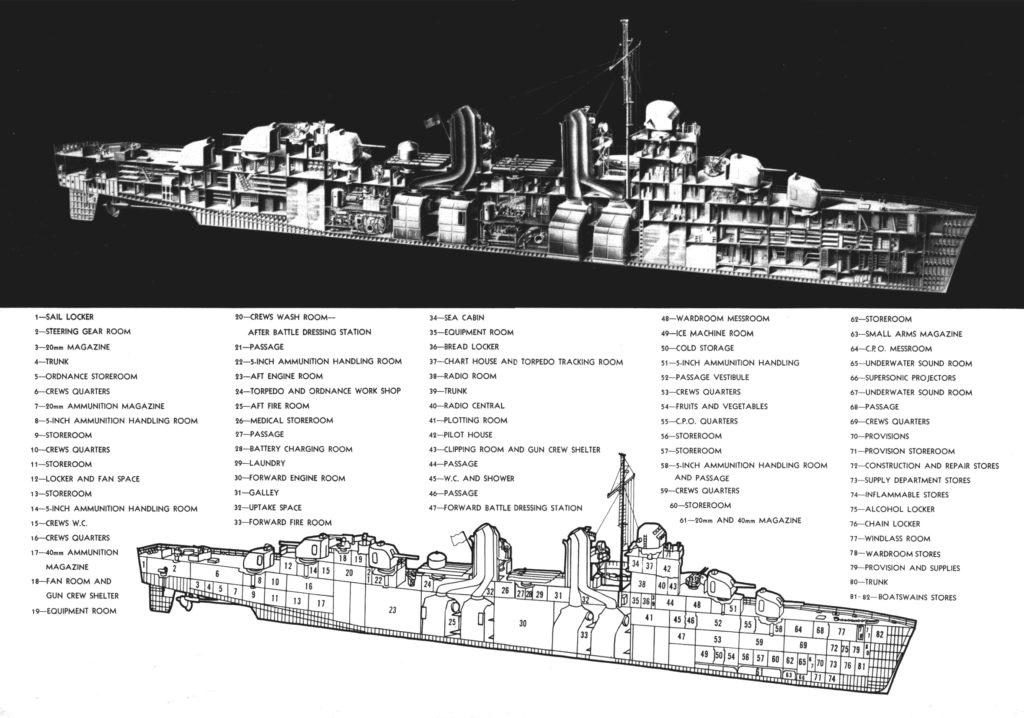
Fletcher class cutaway – Popular science archive (cc)
Design Genesis
The Fletcher class inaugurated a return to the flush-deck hull, seen as more rigid and sturdy for wartime conditions, and also incidentally a bit more simpler in construction. A new semi-automated 5-in/38 gun to better address heavily armed Japanese destroyers was procured, and the two quintuple torpedo tubes banks were maintained in high positions. Designers could achieve a longer and broader hull with a much larger powerplant, 10,000 shp more in output. The Fletchers ended as large destroyers, just 6 inches shy to the British Tribals, way larger than US Emergency Types of the repeat Bensons/Gleaves, of those built in the United Kingdom, and much more advanced in design.
All were equipped with the latest detection equipment, ASDIC-SONAR and radar, modern fire control systems, sophisticated ballistic computer and central operation room. AA artillery at first was limited to a single 1.1-in (28 mm) quad mount and six 0.5 in Browning M1920 HMGs. Trust into the AA capabilities of the 5-in/38 indeed was making light AA almost redundent, but this would quickly change. It was much improved in 1942-44 with twin and quadruple 40 mm guns reinforced by single Oerlikon guns.
The 5-in/38 dual purpose were also now all enclosed, and combined with the rest of the AA, created a triple layer of protection to best protect task forces. Also their quintuple axial torpeddo banks had rapid reload systems, something that would play a crucial role during the Battle of Leyte.
Name: Admiral F.F. Fletcher (1855-1928)
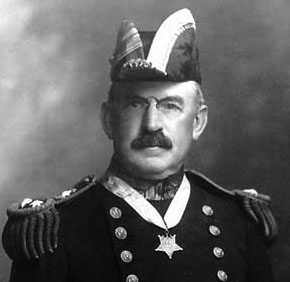 Frank Friday Fletcher, born 23 November 1855 in Oskaloosa, Iowa, was a member of the Naval Academy class of 1875. As Commander of the 1st Division, Atlantic Fleet, he directed the landing at Vera Cruz, Mexico, 21 and 22 April 1914, with distinction which won him the Medal of Honor. He was named Commander-in-Chief of the Atlantic Fleet later that year, ranking as Admiral from 10 March 1915 until completing his assignment in 1916. He served on the General Board until retiring on 23 November 1919, earning the Distinguished Service Medal for his meritorious service during World War I. Twice recalled for temporary active duty, he served in 1925 on a board studying the most effective use of aircraft in national defense. Admiral Fletcher died in New York City 28 November 1928.
Frank Friday Fletcher, born 23 November 1855 in Oskaloosa, Iowa, was a member of the Naval Academy class of 1875. As Commander of the 1st Division, Atlantic Fleet, he directed the landing at Vera Cruz, Mexico, 21 and 22 April 1914, with distinction which won him the Medal of Honor. He was named Commander-in-Chief of the Atlantic Fleet later that year, ranking as Admiral from 10 March 1915 until completing his assignment in 1916. He served on the General Board until retiring on 23 November 1919, earning the Distinguished Service Medal for his meritorious service during World War I. Twice recalled for temporary active duty, he served in 1925 on a board studying the most effective use of aircraft in national defense. Admiral Fletcher died in New York City 28 November 1928.
Hull and general design
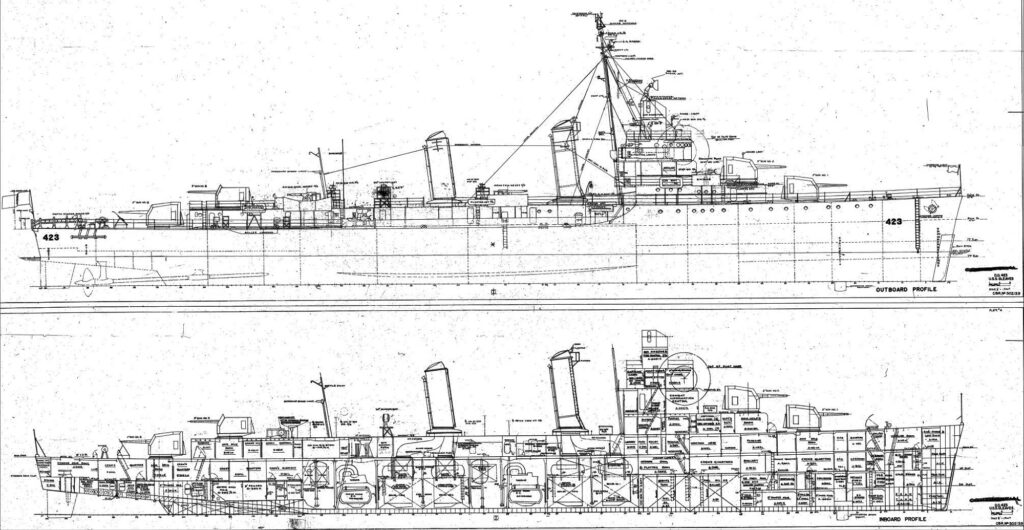

To compare, the Gleaves class, and Fletcher below.
Powerplant
There was no revolution compared to previous designs, at least no braking innovation. Still twin screw, steam propulsion combined geared steam turbines and two-ends oil firing boilers, but however for a total of 60,000 HP to provide something between 35 and 37 knots depending on conditions.
The Superheated steam generated in the four oil burning boilers came from a pressure of 600 pounds per square inch (psi) at 850° F. There were two boilers installed in each fire room, severed by a single stack, same allternated arrangement made for the Benson/Gleaves which was “torpedo proof”. The boilers were of the “divided furnace”, or “M” type. They had separated furnaces for steam pressure and temperature control, ensuring the superheating could not go overhand. These boilers became commonplace for USN carriers, battleships and cruisers as well, but they also imposed limitations on the ability to conduct low speed maneuvering quickly.
The two cross compounded geared steam turbine were provided as main engines, which type and brand varied by yard. Similar to previous classes, each was composed of a high pressure and low pressure turbine sets, driving the shaft through a double reduction gear (hence the “geared” turbines). Rated output was 30,000 HP. The shaft turned at 395 RPM. HP and LP turbines were connected in series accoridng to the sens of steam flow but they worked in parallel mechanically, into the reduction gear (also for compacity but the smaller LP turbine was mounted one front end of the HP turbine with Astern elements added to the LP turbine, so to reverse, it was needed to shut off steam to the ahead turbines first. Control was by hand wheels mounted on a large gage board close to the display of the engine telegraph connected to the bridge.
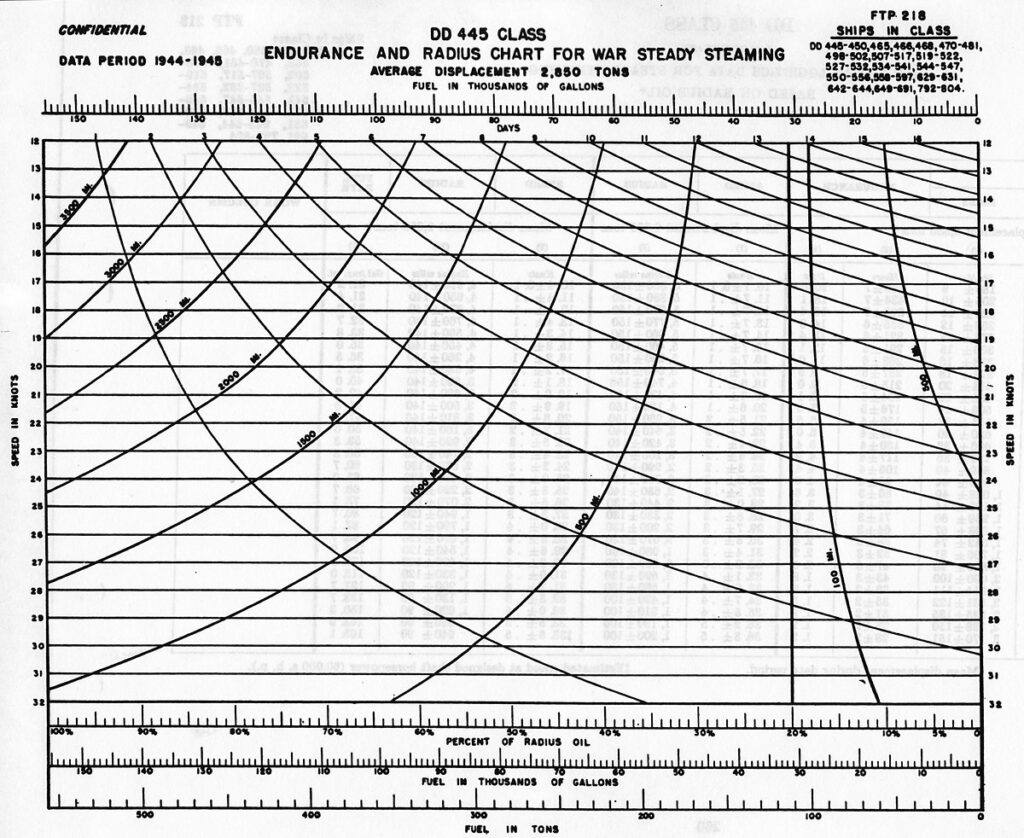
Consumption chart of the Fletcher powerplant.
The Machinery spacese in echelon, alternating fire rooms and engine rooms meant the starboard shaft was 75 feet longer than the port shaft, but the system procured redundancy in case of severe battle damage. The alternated in such a way that the Forward Fire Room contained #1 and #2 Boilers (plus their forced draft blowers, fuel pumps) while the Forward Engine Room contained the Starboard Main Engine, corresponding service generator but also the 12,000 daily gallon distilling plant and associated equipment.
Immediately nearby was the Control Engine Room headed by the Engineering Officer of the Watch coordinating the operations and communicated with the bridge, Chief Engineer in battle conditions.
The second Fire Room contained the thord and fourth Boilers and the second Engine Room was a mirror image of the Forward one, to Port.
The “Split Plant” system ensured to have fully independent engineering plants. When running on just two boilers on trials these ships were seen able to reach 28 knots which was perfect to escape the danger area after damage that would shut down one of the two.
Access to these by hatches and vertical ladders was completed by egress hatched port and starboard but to keep the entire section flood-proof there was no access between the machinery spaces below the Main Deck. It was bulkheaded. The entire machinery spaced took less than 1/3 of the total hull lenght. Also the funnels had rounded sides on all ships.
Armament
5-in/38 guns
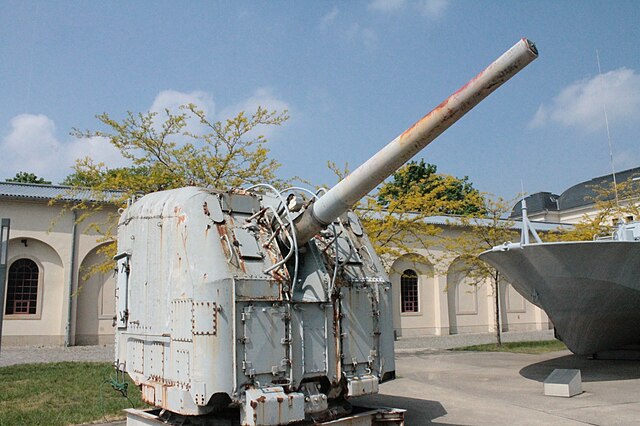
Preserved 5-in/38 gun at the Bundeswehr Museum in Dresden.
The class was completed with four or five 5-inch (127 mm) dual purpose guns (anti-surface and anti-aircraft (AA)), controlled by a Mark 37 Gun Fire Control System as in the previous Sims class.
This was a powerful armament, well completed by ten torpedo tubes.
⚙ 5-in/38 Mark 12 specifications |
|
| Open Mount full weight | Mark 30 mount Mod 1: 33,500 lbs. (15,195 kg) |
| Enclosed Mount full weight | Mark 30 mounts Mod 41: 41,400 lbs. (18,779 kg) |
| Barrel | 3,990 lbs. (1,810 kg) without breech, 223.8 in (5.683 m) long |
| Muzzle Velocity | 2,500 fps (762 mps) average |
| Rate of Fire | 15-22 rounds/minute |
| Elevation | -10 to +85° |
| Range | Max 85°, 2,940 yards (2,688 m) |
| Crew | 8 inside, 7 outside open src |
| Ammunition | Bensons: 320 (Gleaves 360) |
| Penetrating power | 13,800 yards (12,620 m): 1.0″ (25 mm) armor* |
*with special common shell
Torpedo Tubes
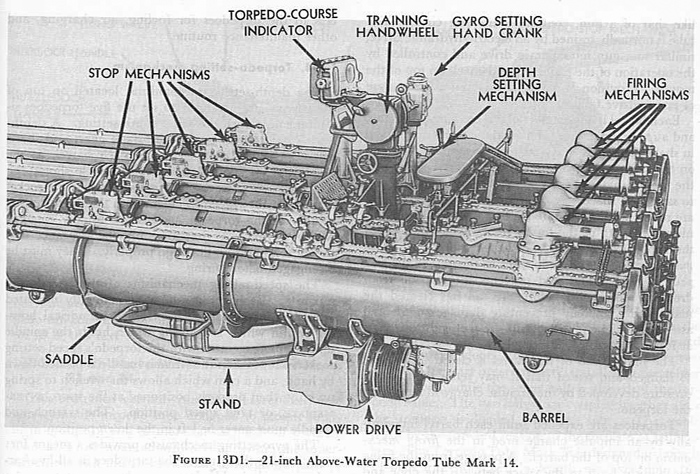
ONI explanation on the Mark 14 Quintuple Bank of the Benson-Gleaves (from navweaps).
The adoption of quintuple banks, the norm on the USN until heavy torpedoes were dropped altogether in the 1960s, was the fruit of numerous critics about the aside arrangement of banks (On all DDs since the Farraguts, as they were reported to be regularly hammered by waves, conducting to failured, deformations and heavy corrosion. Thus on FY1939 program destroyers built by FY1938 design the admirakty decided to rearrange all torpedo tubes to centreline, and raised well above the deck by a full structure, out of harm of sea spray. This also enabled place for spare torpedoes. The tradeoff put an end to the old trope of “scissors fire” or curve-ahead fire enabled by using a setting for the side banks. The admiralty wanted to preseve firepower and was assured by the Bureau of Ordnance that it was possible to mount a fifth tube on the regular, but upsized bank in use until then.
This for the first time, a US destroyer (any destroyer in the world for that matter) earned a quintuple torpedo tube bank. While the European norm was two triple, or two quad bank, a broadside of ten torpedoes was the greates ever achieved by any destroyer in service at the time. The Japanese typically had three triple banks, but that went for nine torpedo broadside, however the reload system was faster. The 14 reloads (or 10 dependong on sources) were stored close to the banks, and it was a manual (still helped by a crane and winches) and risky, long operation requiring a calm sea state. It was assumed that once the broadside was spent, the ship was down to its artillery for the remainder of the fight.
There were concerns about such a large torpedo salvo, but the successive launch allowed to alleviate wake interferences. Bureaucratic delays had however the number of spare torpedoes under specification limited to four, so the ship had on paper just 14 including the ones already loaded, or just ten, so no reloads at all. See a color rendition of the mount.
The MK 14 and MK 15 torpedo tube mounts were both capable of launching the 21-inch MK 15 torpedo. The trainable, quintuple arrangement was derived from the quadruple one with a larger base. Each mount comprises a stand, saddle, barrels, controls, heating equipment, and the caracteristic rounded blast shield on the MK 15 mount only. The latter was was installed to protect the crew from nearby 5-inch gun blast but the rest was were identical between the two Marks. Stand and saddle were equivalent of a base ring/carriage for a standard gun mount. The first was bolted to the deck, housing the training circle and bearings for the saddle.
The latter supported five barrels in a parallel arrangement, secured via hold down clips. Barrel assemblies comprised the main barrel, door and spoon extension bolted to the saddle via ring flanges. Doors aft (breech end) were hinged. Spoon extensions forward were also hinged, folding backwards on top of the barrel for better access to the torpedo warhead. Controls of the torpedo gyro and accesss to the depth and speed settings were fitted atop the barrels, aft of the ring flanges. They were electrically input. There were also two rows of barrel heaters underside close to the torpedo mechanisms as de-icing implement in cold weather.
The firing mechanism on top of each tube was located on aft end forward of the breech doors. They were launched individually by ignition of black powder from impulse cartridges that were to be replaced each time, fired either by hydraulic percussion or electrically. They were re-trigerred by a tripping latch after the torpedo left the muzzle.
Each Benson class ship has a pair of retractable loading cranes (one for each bank) and chain fall holding the torpedo to be aligned with the tube when reloaded, then manually pushed into the tube.
The while operation was too long and needed too pristine conditions to be carried out in the heat of battle.
⚙ Mark 14 Bank, 21-inch MK 15 Mod 3 torpedoes specs |
|
| Weight | 3,841 lbs. (1,742 kg) |
| Lenght | 24 ft (7.315 m) |
| Settings | 4,500 yds/45 kts – 9,000 yds/33.5 kts – 14,000 yds/26.5 kts |
| Propulsion | Wet-Heater steam turbine |
| Warhead | 801 lbs. (363 kg) TNT or 823 lbs. (373 kg) HBX |
| Exploder | Contact |
| Guidance | Mark 12 Mod 3 gyro |
| Reloads | Bensons: 0 to 4 |
AA armament
It varied already between completed vessels: DD445 to 451, 465, 467 and 468 for example received the quad 28mm/75 Mk 1 completed by four 20mm/70 Mk 4 Oerlikon.
DD466, 469, 478, 507, 508, 569 however were the first to received the twin 40mm/56 Bofors Mk 1.2 in place of the 1.1 in Mk.I. This became standard, with the four Oerlikons, until DD470 to 472, 476, 498 to 502, 509 to 513 and DD 570 to 573 which gained sponsons platforms for two twin 40mm/56 Mk 1.2, and six single 20mm/70 Mk 4. This was just the beginning. DD473 to 475, 481, 514 to 517 and 574 to 577 this jumped to three twin 40mm/56 Mk 1.2 Bofors and 11 single 20mm/70 Mk 4 Oerlikon AA guns, still without any sacrifice.
For the “catapult destroyers” seen below, DD477, 479, and 480 N°3 main gun was sacrificed, leaving the four superfiring 5-in/38 Mk 12 fore and aft, a twin 40mm/56 Mk 1.2,and eight single 20mm/70 Mk 4, but a seaplane catapult, which was not tried for very long. Their armament was probably readjusted to the 1944 Fletcher standards after its removal.
DD518 to 521, 526 to 530, 544, 581, 587 to 589, 629 to 631, 659 to 661, 666, 667 as a variant had only ten Oerlikon 20 mm AA guns as completed.
Later Fletchers of 1944 were completed with an emphasis on Bofors as it became clear that the 20 mm were useless against Kamikaze. DD522, 531 to 541, 545 to 547, 554 to 568, 582 to 586, 590, 591, 594 to 597, 642 to 644, 649 to 658, 662 to 665, 668 to 691, 792 to 804 had five twin Bofors and seven 20 mm Oerlikon, all single. This was still not the pinnacle of AA configuration, which evolved over previous shiops during overhauls. The late Fletchers of the DD550 to 553, 578 to 580, 592, 593 had the same Bofors complement but six Oerlikons.
See details for these weapons systems below, and later the wartime modifications.
1.1″/75 caliber gun ‘Chicago Piano’
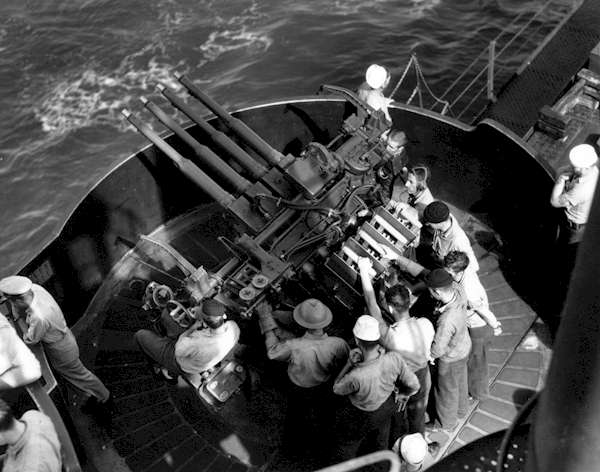
1.1″/75 caliber gun ‘Chicago Piano’ on board USS Enterprise. It was quite rare on american destroyers.
This standard ordnance, 28 mm caliber, designed to replace the designed to replace the M2 Browning and therefore placed always in quad mountings to reival the rate of fire of the latter, the 1.1 ca. started to be installed in 1938 onboard many ships of the USN and was mounted at the range of one mount for a destroyer, and around 1000 produced total which ceased on 1942 as the USN hade found the perfect combination with the quad-40 mm Bofors and single 20 mm Oerlikon. Even after its problems had been ironed out, the navy flagged it in reports as too heavy to be used as a “last-ditch” free mount and too light to fill the void between MGs and and the 5-inch guns.
1″/70 caliber Oerlikon (20 mm)

20 mm Oerlikon gun
The famous “Oerlikon gun” was the proverbial light AA gun of the US Navy during the war and is still on service today in many navies around the globe, a testament of its core design and usefulness. Packing quite a better punch than the legendary heavy AA machine gun, the 1920 Cal.50 (12.7 mm) M2HB Browning, this 20 mm gun (1-in) started during WW1 as the “20 mm Becker” using an Advanced Primer Ignition blowback. It was fed with 20×70mmRB cartridge and had a cyclic rate of fire of 300 rpm, used by several Luftstreitkräfte planes and as AA ordnance in 1918. However the Versailles treaty banned the development of such armament, and the licence was sold to Neutral Switzerland, Seebach Maschinenbau Aktien Gesellschaft of Zürich (SEMAG).
The firm relaunch development in 1919 and produced the heavier SEMAG L in 1924. But the companu filled a bankrupcy and its assets were taken over by a new company that took the name of a suburb of Zürich, Oerlikon. In 1927, the firm launched the heavier Oerlikon S, using a 110 mm cartridge, with a slower rate of fire but faster muzzle velocity, almost double of the Becker design of 1918. It was proposed on the market as AA and AT gun. The range later comprised the AF and AL as aircraft mounted guns, and the success was quick. It evolved in 1935 into the FF, FFL and FFS family, still for aircrafts. In France it was licenced to Hispano-Suiza, as well as in Germany, Ikaria and in Japan as Type 99-1 and Type 99-2.
But for ships, as AA gun, the Oerlikon SS (1938) came as the standard shielded version for Navies. It was widely adopted and licenced as is, and evolved, refined into the 1SS of 1942, and the 2SS of 1945. It was also widely adopted during the war by the Royal Navy as a short-range anti-aircraft gun, complementing the ubiquitous “Pom-Pom”. Deliveries started in 1940 at slow pace, imported from Switzerland, and it started under licence in the UK, at Ruislip, London. In the US Navy, the 20 mm SS logically replaced the M2 Browning machine gun and was manufactured in US state arsenal and contracts went to numerous automobile manufacturers including Hudson and General Motors.
Total production during the war reached about 100,000 to 120,000 according to several sources. This was enough to be fitted on all USN major warships and destroyers. It was coupled with the MIT-designed electric Mark 14 gunsight. The latter triangulated an aiming point on a fast-flying aircraft, thanks to two gyro stabilization. The usual provision of USN destroyers was 5-6 on the old “four-stackers” and their wartime variants, 4-6 on some modernized interwar american destroyers, 4 on the Benham, Fletcher, and 11 on the Sumner and Gearing classes.
2″/50 caliber Bofors (40 mm)

40 mm quad Bofors
The anti-aircraft autocannon designed in the 1930s by the Swedish arms manufacturer AB Bofors became a legend, widely used on all sorts of ships, from aircraft carriers to humble MTBs and minesweepers or sub-chasers. As a testament to its reliability and hard-hitting qualities, it is still in service around the globe today in many configuration. Called “Pom-pom” in the Royal Navy where it was used in often octuple mounts for compacity, it was the staple of AA defence in medium-close range, the last line being provided by the also ubiquitous and long-living 20 mm Oerlikon, this time of Swiss origin. Both the Bofors, most often in quad mounts, and the Oerlikon shaped the AA defense of allied ships during WW2. Their limitations were recognised but the volume of fire they provided procured a solid last-ditch steel wall.
In the USN, the 40 mm was adopted during the war after seeing the British model in action. Chrysler built 60,000 of the guns and 120,000 barrels through the war, at half the original projected cost, filling the Army and Navy’s needs by 1943, resting on a large network as shown by the 2,000 subcontractors in 330 cities supplying Chrysler. By productivity alone, manufacturing time was halved until 1945. Chrysler’s engineers indeed simplified the manufacture, improved performance and allowed others to copy the model with minimal licencing fees.
Although it was used also in single and twin mounts (like on the Fletcher class), when toom was available, on late Destroyer types, cruisers, battleships and ACVs, the bathtub-like MK 12 quadruple mount became standard.
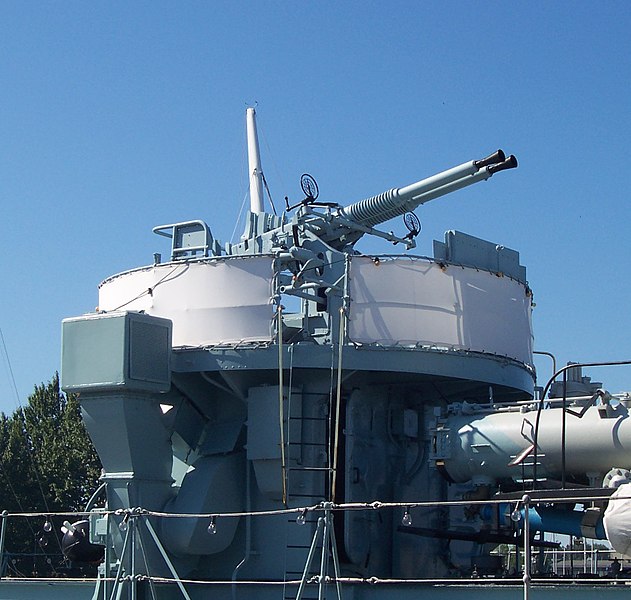
Twin Bofors variant used in the Fletcher class (Here, Polish destroyer ORP Blyskawica).
The Bofors needed five men to operate effectively: A gun commander, adjusting the range and angle, two gunners, one responsible for the traverse and another for the elevation, and two loader, on each side, filling and replacing ready-round clips magazines, each with four. This provoked most often than not 16-round bursts cycles, but 900 g (2.0 lb) high explosive 40 × 311R (rimmed) shell at 2,960 ft/s (900 m/s) could reach 120 rpm with a well-trained crew. They could hit a target at 7,200 m (23,600 ft), but the practical maximum was about 3,800 m (12,500 ft). It came in 60 and 0 caliber barrel lenghts.
The 40 mm was gradually replaced in the USN at the beginning of the cold war, notably by late version of the 3-in (see above). Production and uprades were maintained for land uses, and the venerable piece of ordnance is still manufactured by Zastava Arms, United Defense Industries and BAE Systems AB.
These destroyers also had the capability to lay smoke screens.
ASW armament
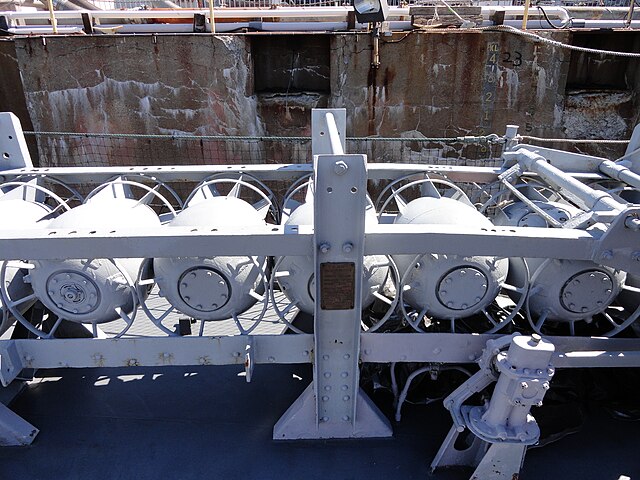
The new teardrop Mark 9 on USS Cassin Young
Standard issue for these destroyers were six DCT (Depth Charge Thrower or K guns located aft on either side, and two 10-DCs depht charge racks aft for a grand total of 56 depht charges.
Mark 7:
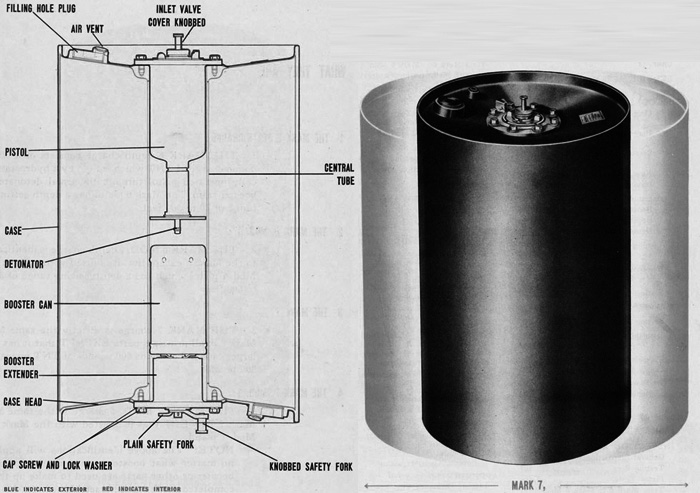
The models used were likely the Mark 7 as completed. Design in 1937 and entering service the following year, they weighted 745 lbs. (338 kg) and carrid a 600 lbs. (272 kg) TNT warhead woth a sink Rate and Terminal Velocity of 9 fps (2.7 mps). It had settings from 50 to 300 feet (15-91 m).
Basically a redesigned Mark 4 which became standard on all destroyers, Destroyer Escorts and ASW ships in the early part of World War II. Its redesign was for simplifying construction. Mod 1 arrived from August 1942 and doubled the depth setting to 600 feet (183 m) given reports of U-Boats capable of reaching more than 250 m. Mod 2 had a warhead ported to 400 lbs. (181.4 kg) TNT with a greater sink rate of 13 fps (4 mps).
Mark 8:
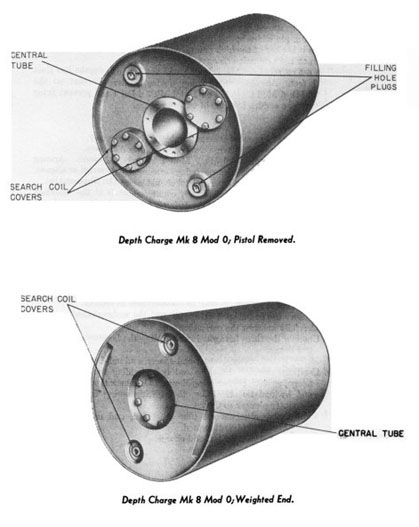
Designed in 1941 and introduced in 1943, this model used a magnetic pistol and was built with an aluminum casing to avoid magnetic interference. This was far more advanced “proximity” model, far more accurate that preset depht charges of old. Weighting “only” 525 lbs. (238 kg) it still carried 270 lbs. (122 kg) of TNT and had a sink rate of 11.5 fps (3.5 mps) with settings between 50 and 500 feet (15-152 m). The USN considered it 7x more lethal than the Mark 6 or even the following Mark 9. But when it exploded…
It was indeed unreliable and maintenance-heavy. So much so that a backup hydrostatic pistol was fitted and by 1945 the model was retired from service. The magnetic pistol armed itself when detecting the hull from 35 feet (11 m) to 200 feet (61 m) and then exploded when 20-25 feet (6-7.5 m) close. Too light, it was assorted by a 150 lbs. (68 kg) lead weight. Great hopes were placed on this model, almost a USN “secret weapon” to win the war in the Atlantic, with 76,000 built, but crews soon discovered its flaws and it was quickly withdrawn after the war with some 57,000 still in storage by September 1945.
Mark 9:
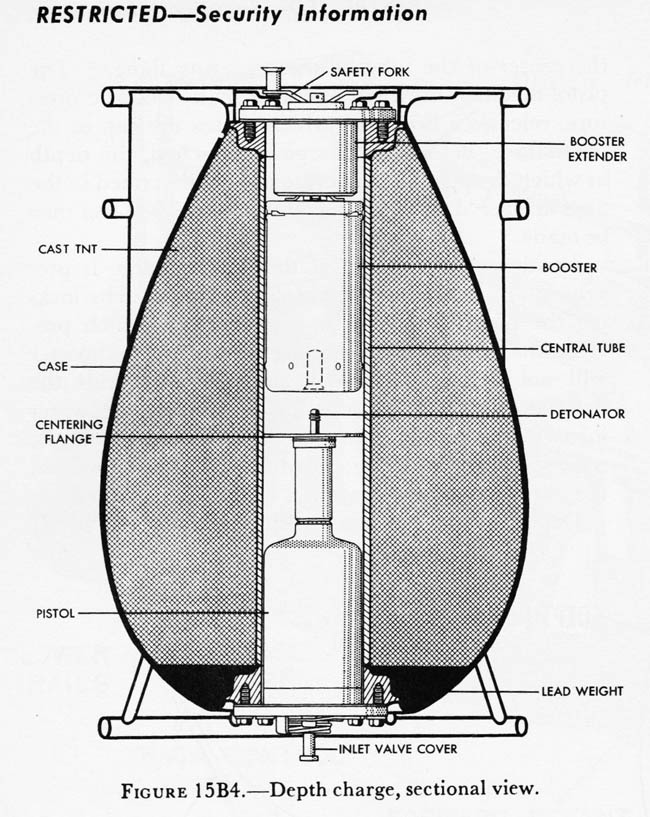
Same generation as the Mark 8, this became the standard-issue DC from 1943 to 1945 and well beyond. Esentially similar technically as the previous Mark 7, they had however a “teardrop” shape enabling as tested a much greater sink rate, with fins to create a stabilizing spin enabling it to even sink more accurately. The Mod 2 could be setup to 1,000 feet (305 m), the warhead TNT was replaced by Torpex and the sink rate could be reduced if needed to 15 (4.5 mps) by fitting spoiler plates on the nose, acting as brakes. They were provided as kits for slower warships (DEs, Frigates and Sub-Hunters), to allow them to escape the explosion plume.
Depending on the version, Mod 0, 1 and 2, it weighted 320 lbs./145 kg, 320 lbs./145 kg and 340 lbs. (154 kg) respectively, with a warhead ranging from 200 lbs. (91 kg) TNT to 190 lbs. (86 kg) on Mod 2. Sink rate also varied, respectively 14.5 fps (4.4 mps), same and 22.7 fps (6.9 mps).
Settings were about the same as the Mark 7, from 50 to 300 feet (15-91 m) or 600 feet (183 m).
About the K Guns (Mark 6)
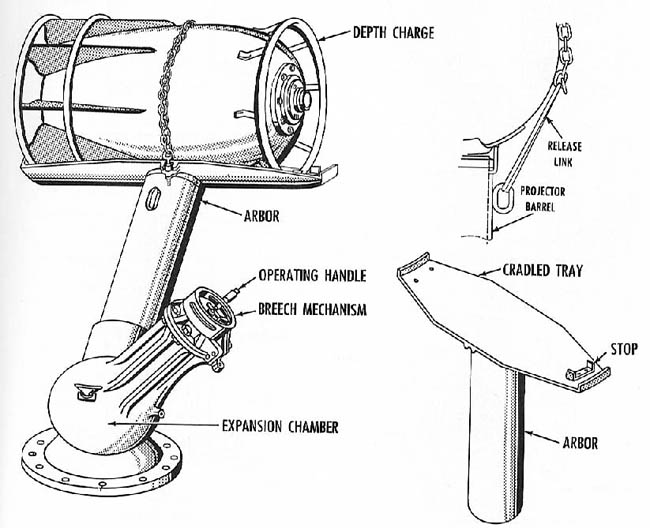
The USN standard Depth Charge Thrower (DCT) in WW2 could be either the Mark 6 or the Mark 9 “K-gun”. A successor to the 1918 “Y gun”, this new model was geared towards quick reload and more power to throw the DC as far away as possible from the ship’s hull.
The Projector Mark 6 was introduced in 1941, furing a single Mark 6, 9 or Mark 14 depth charge. Distances achieved range from 60 to 150 yards (55 to 137 m), in just 3.4 to 5.1 seconds. Generally all destroyers equipped had them placed by three either side aft on the deck, close to the aft deckhouse. Four to six for destroyers, but up to eight on destroyer escorts. They soldiered on until the 1950s and production was such they were also provided largely by lend-lease.
Each K-Gun was composed of an arbor (holder) inserted into the projector to hold the depth charge, loaded next onlto it. It fell into the sea but was not recuperable, unless a cable was attached to it, but it was considered a hazard. They were expandable cheap metal pieces. These were partly made of a tube measuring 61 cm x 15 cm, closed on one end and ending with a tray 12 by 31 inch (30.5 x 79 cm) on the receving end. It was conveived to fit into the projector barrel and became the main projectile when fired. They weighted at first 70 lbs. (32 kg) down to 65 lbs. (29.5 kg) on later models, increasing range.
The K-Gun propellant used was black powder. The arbor was loaded into a 3″ (7.62 cm) tubular casing. The loads varied between the ordered range, either 60, 90 and 150 yards (55, 82 and 137 m), varying the charge.
The Mark 9 was had a built-in arbor tested in 1944 on USS Asheville (PF-1) but the system was complex compared to expandable arbors, and it was too costly to justify production.
It is estimated that thousands of tons of arbors layed in the Atlantic seabed after WW2, probably now all rusted away as they received no special treatment.
Sensors
The picture is somewhat more difficult to establish without precise records.
The early series, DD445 to 451, 465 to 481, 498 to 502, 507 to 520, 526 to 528, and 569 to 576, 587, 588, 629 and 659 to 661 were equipped with the SC, SG surveillance radars and Mk 4 fire control radars, as well as a QCJ sonar. Later series replaced the Mak 4 by Mk 12.22 radars and from the DD594 to 597, 655, 656, and 799 to 804 the SC radar was replaced by the SR radar.
SC radar
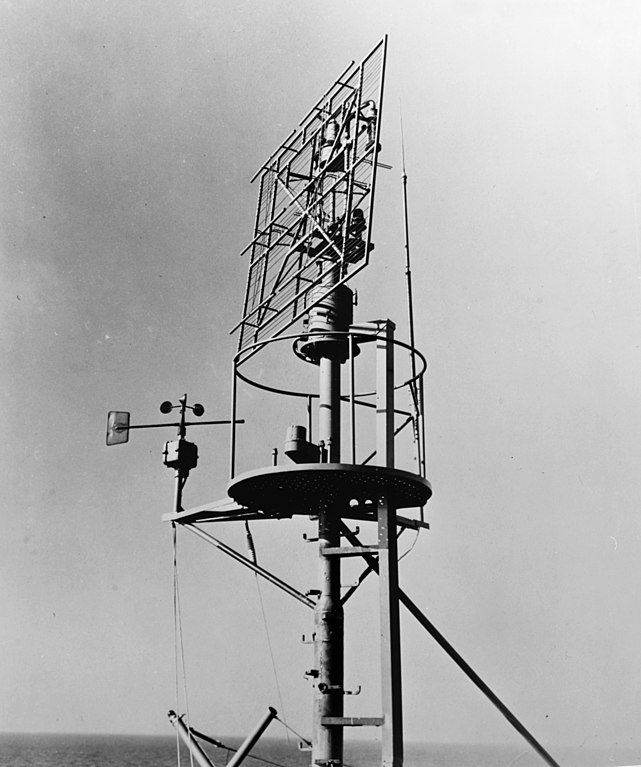
Introduced in 1942 this classic among classics 220 kW Air/Surface-search radar worked on VHF band:
PRF 60 Hz, Beamwidth 10–25°, Pulsewidth 4–5 μs, Range 48–120 km (30–75 mi), Precision 90–180 m (98–197 yd)
Mark IV FE FCS Radar
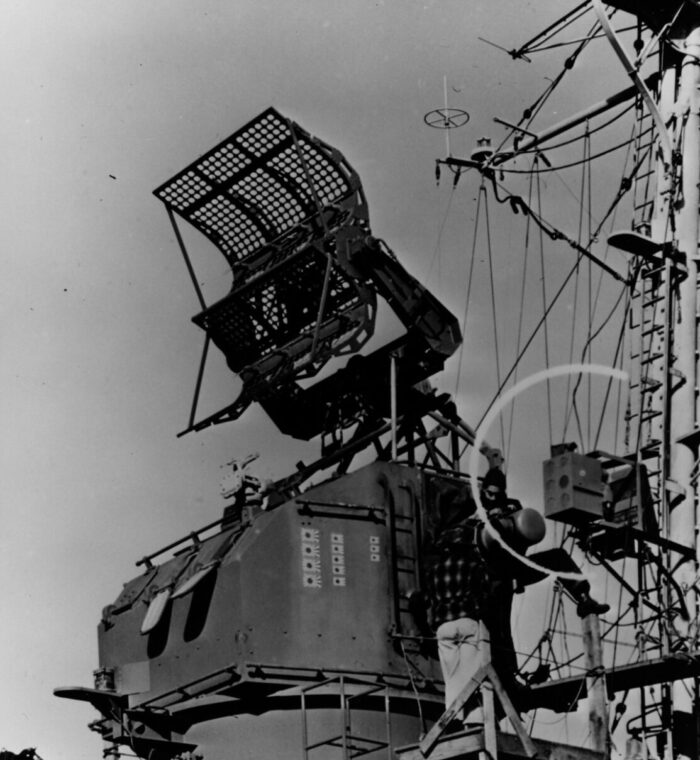
The Radar Mark 4 Or Type FD was mounted on top of the Mark 37 Fire Control System. Photo; USS McCalla, 5 January 1944. src Naval History and Heritage Command.
Specs:
Bearing Accuracy 0.225, Bearing Resolution 10, Horizontal Beamwidth 12, Vertical Beamwidth 12
Range Accuracy 37m, Range Resolution 365.76m, Range in Nautical Mile 19.966
Radar Antenna Siz 1.829 m
QC Sonar
The U.S. Naval Research Laboratory developed the first “QA” sonar, which was to become the first destroyer-mounted, echo-ranging sonar in the U.S. Navy, operating at 15 to 20 kHz. By 1933, the QA sonar was installed on eight destroyers. Subsequent improvements in transducer technology yielded the QC series, which was installed as a standard ASW active sonar on all U.S destroyers at the outbreak of World War II (Friedman, 1988). When two-letter designators were used for U.S. Navy equipment, the first letter indicated the type of equipment (Q represented Sonar Echo Ranging
Listening equipment) and the second letter indicated the subtype of the equipment. src and also and this.
Mark 12.22 FE FCS Radar
Thee Mk. 12 operates in UHF-Band and is a fire control radar combined with the standard director Mk. 37 guiding the 5-inch guns. It had automatic tracking for range and measurements in real time and the antenna presented two main cylindric parabolic reflectors one on top of the other, 4 ft long x 2 ft high for 1/4 wavelength, 8 dipoles each, electrically connected in four groups of 4 dipoles connected to a lobe switch, positioning the beam in up to 4 positions. A smaller antenna Mk.22 radar (“orange peel”) parabolic cylinder 2ft in diameter fed by two dipoles was addedto suppress the side lobes of the main antenna. The combined result was called Mark 12.22. Like the Mark 4 however it had still low elevation angles.
SR Radar
ADA457262.pdf all radar types pdf
No information yet.
Modifications (armaments)
By the autumn of 1942, all but three received a twin 40mm/56 Bofors Mk 1.2 in place of their Mark 1 AA gun. By late 1942 the new norm was two twin 40/56 Mk 1.2 Bofors and six 20mm/70 Oerlikon Mk 4. By early 1943 this went up to nine 20mm/70 Mk 4 AA guns. By 1943-1944 the new standard was three twin 40mm/56 Mk 1.2, and either tent or eleven Oerlikons. By late 1943 soe had five twin 40mm/56 Mk and seven oerlikons (mirrored by newly completed ships)
By the summer of 1945, the new standard for about 25 ships, notably those in picket radar duty was now two quadruple 40mm/56 Mk 1.2 and three twin 40mm/56 Mk 1.2 plus four 20mm/70 Mk 4 AA guns and three single 20mm/70 Mk 4 to the sacrifice on the aft torpedo tubes bank. In 1946 many were given the same Bofors suite, but four twin 20mm/70 Mk 24 plus three single 20mm/70 Mk 10, again without “B” torpedo tubes bank. This made for a total of 14 Bofors and 11 Oerlikons.
Other ships at the same time kept their five twin Bofors Mk 1, and seven single Oerlikon Mk 10, but also both torpedo tubes.
The choice to sacrifice one TT banks reflected technology changes which had an immediate impact on tactics: The invention of radar essentially destroyed any stealth advantages that the destroyer possessed. Until 1944, The class drills and main tactic was by the “John Wayne” method, a 25 knot approach, firing the torpedoes and high speed retreat. The slower speed did not created much smoke of wake turbulence, somewhat reducing chances for the destroyer to be spotted, especially at night. Thus with the increasinly hostile AA threat and a Japanese Navy practically anihilated after the battle of Leyte, the choice of sacrificing a torpedo tubes bank, the aft one, to fit instead two large quad Bofors 40 mm, sponsons over the aft deckhouse and covering the entire width of the ship, was not a hard one. Fourteen Bofors and 11 Oerlikon, the largest AA complement in 1945 of any US destroyer before the Sumner/Gearings, were still barely able to defend the fleet against fierce Kamikaze attacks. The role of picket duty, forcing a Fletcher to be posted, immobile and isolated, was an especially tough one. This AA cover was to be able to repel entire air squadrons. Losses were many.
This was such a risky assignement that generally destroyers made a single turn in this role, never or rarely two missions as picket ships. Experience of losses in this role for surface ships soon led to the adoption of submarines for this role. They could dive for safety when came an air attack. But the concept was only developed postwar.
Another wartime modification was to install a Combat Information Center (CIC) to receive data from radars aboard, and manage, coordinate the weaponry. It was installed in available rooms, ofter the former commander’s cabin. On the Sumner/Gearings a room was tailored for this.
Life on board
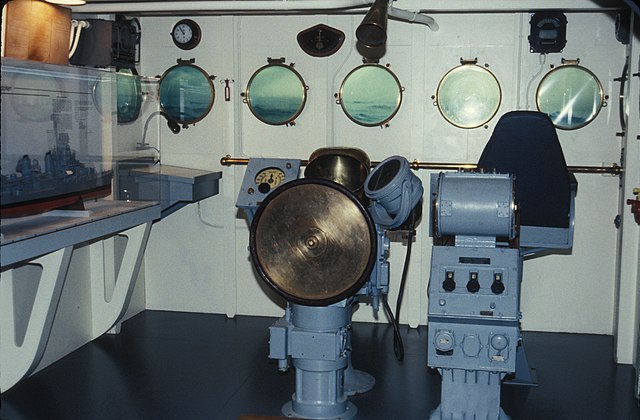
The bridge of USS Fletcher in 1972.
Envionmentalism did not existed at the time, and all trash and garbage was dumped overboard at sea. Although the Fletchers were less top-heavy than previous classes, which enabling the installation of many equipment and weapons without redesign along the war, they became “the” destroyer design of the time, so much so that the the Allen M. Sumner and Gearing were mere derivatives. In general, and still today, not among US Historians they are considered the best destroyer design of the decade and perhaps in history. This stability was kept even when their fuel tanks were depleted, although the same intructions as previous class to captains prevailed: Sea water ballast was injected directly into the fuel tanks to maintain stability under light loading conditions. Deballasting operations at sea took hours in order to properly clean up the thick oil slick. Machinery spaces received extensive asbestos insulation to protect aother decks around from the heat.
Living accommodations were certainly less cramped than previous classes, but still, sailors were berthed in 4 high tiers of canvas bunks (from top to bottom), with upright lockers. There was thus little space between each one and noise or vital space was certainly not brillant. Water closets were only two, and common, so privacy was inexistant for sailors, and only existed for officers.
Portholes for ventilation went away from design specifications for simplification, and there was no air conditioning. The galley was located on the main deck, all food thus needed to be carried down in large trays to the mess deck below. Another drawback dictated by the heavy compartimentation of the ship was that no fore and aft passage existed inside and there was no way to reach the stern or prow other than by the external narrow deck passage, perilous by bad weather.
The Chief Petty Officers had their own mess, although apart the commander, their berthing accommodations were of the same type as the crew. Officers had still shared accommodations, although better and with more privacy and only the captain had his own cabin, plus a small sea cabin close to the bridge. The Executive Officer (XO) was located below and had his own statesroom. The wardroom and officers mess was located on the Main Deck forward, also close to the bridge for quicker access. One deck below were two man staterooms for officers sharing the same head. On “luxury” unique to the Fletcher class and soon retrofitted in rebuilt US destroyers in WW2 was the installation of an ice cream maker. It was free for all when not on duty and was added following the prohibition, when alcohol was forbidden aboard, and this measure was maintained up to WW2 unlike for example in the RN, which the rhum ration was still “mandatory”.
Construction Prowesses
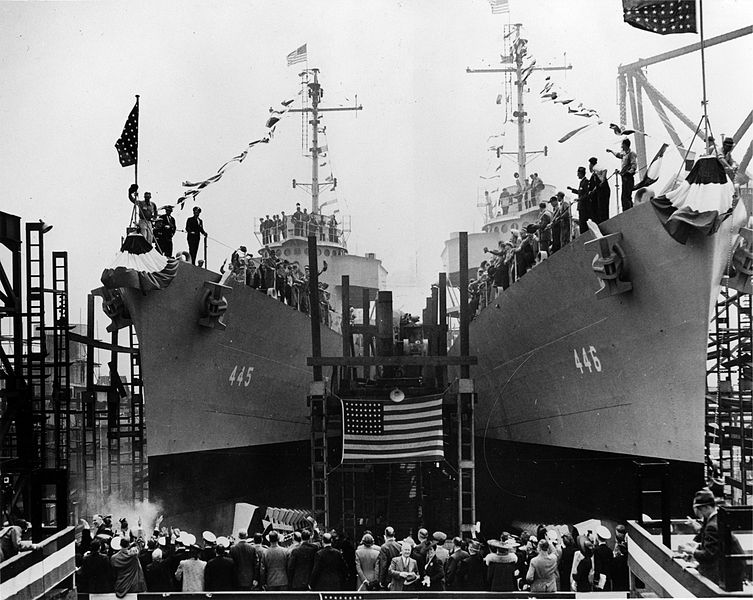
USS Fletcher and Radford, DD445 and 446 are launched the same day in May 1942 at Federal, Kearny SBDD. The first of the class.
The speed of construction for this class was remarkable. The pace, urged by the 1942 emergency program, accelerated in wartime. Already USS Fletcher was laid down in early 1941, and all 175 Fletchers were completed between June 1942 and February 1945. On average 212 days went on between keel laying and commissioned, and 152 days less on average compared to the Bensons and Gleaves that preceded them or were built in parallel for the “repeats”. All in all, this delivery speed became a compeition between yards. It never reach the pace of Liberty-ship construction due to a more complicated design, but still the parts supply chain was constantly improved until the point the whole process was more efficient.
There was also a stream of constant innovation in simplifying the design to reach a faster pace.
It was mostly the emphasis on anti-aircraft defense which in parralel to simplification led to the replacement of the traditional rounded pilot house inaugurated on the Sims, to a new “square” bridge for improved all-around sightlines, which was also one deck lower, improving stability. USS Brownson (DD 518) was the first of this sub-group, of these 2,100-tonners with one third or 58 being of the “high/round-bridge” type and the remainder, 2/3 or 117 of the “low/square-bridge” type.
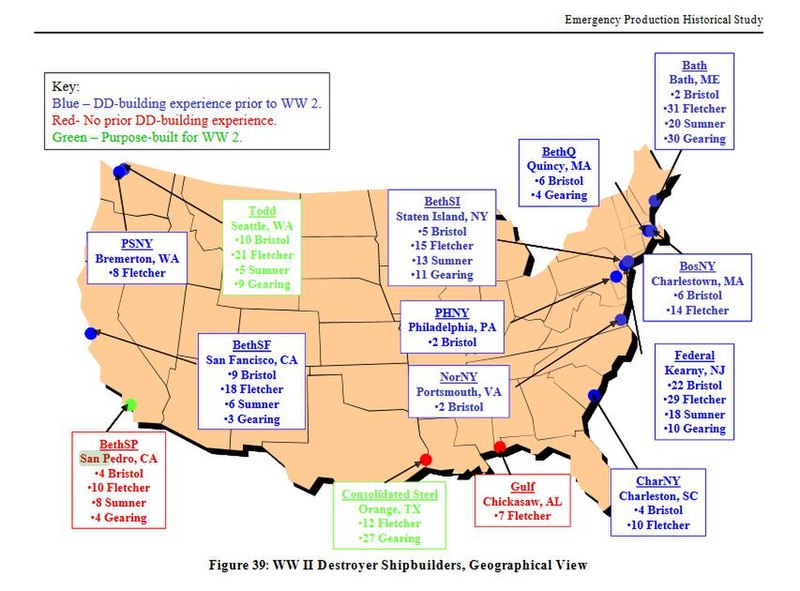
⚙ ships built by yard |
|
| Yard | Ships launched |
| San Francisco | 18 |
| Staten Island (NyC) | 15 |
| San Pedro | 10 |
| Bath Iron Works | 31 |
| Federal Shipbuilding | 29 |
| Seattle-Tacoma Shipbuilding | 21 |
| Boston Navy Yard | 14 |
| Consolidated Steel | 12 |
| Charleston Navy Yard | 10 |
| Puget Sound Navy Yard | 8 |
| Gulf Shipbuilding | 7 |
Appearance
The Sullivans as completed, of the squared, low bridge type.
The Fletcher class are a prized collectionable for modellers, as they were declined into all the wartime liveries of the USN in WW2 as shows the example above: MS12, 14, 21, 22, 31/10d and 16d, and MS 32/6d among others were applied to the class. Here are example on shipcamouflage.com
HD Author’s Profiles

USS Fletcher in June 1942 as completed

USS Fletcher Ms12, battle of Tassafaronga November 1942

USS La Valette, MS 12 late 1942

USS Leutze Ms36 scheme 16d, 1944

USS Twiggs (low bridge type) MS32/6d, 1944

USS Kidd (Low bridge Type), Ms22, 1945
⚙ specifications |
|
| Displacement | 2,050 tons standard, 2,500 tons full load |
| Dimensions | 376.5oa x 39.5 x 17.5 ft (114.8 x 12 x 5.3 m) |
| Propulsion | 2 shafts turbines, 4 boilers, 60,000 shp (45,000 kW) |
| Speed | 36.5 knots (67.6 km/h; 42.0 mph) |
| Range | 5,500 nmi (10,200 km; 6,300 mi) at 15 knots |
| Armament | 5x 5-in/38, 2×5 21-in TTs, variable AA, see notes |
| Sensors | Mk37, GFCS SC surveillance radar, SG air-search radar |
| Crew | 329 (1942) |
Modifications

USS Nicholas overhaul in 1944
During the war, while construction was going on, many modifications were made notably for the too exposed bridge for a new “low bridge”, squared and reduced for simplification and enabling greater AA arc, as well as countless additional adjustments for better crew accomodations, additional AA, even with the sacrifice of a single TT Bank.
Their detection equipment was also improved, along with their AA radar-guided fire control in 1944-45. Their career was long enough to undertake the bulk of Pacific operations, with impressive battle records, unmatched for any wartime destroyer class. They became the most decorated US destroyers in history. They were however gradually replaced by a new generation capitalizing on extra firepower with three twin 5-in/38 guns, the Allen M. Sumner and Gearing classes.
Catapult Destroyers
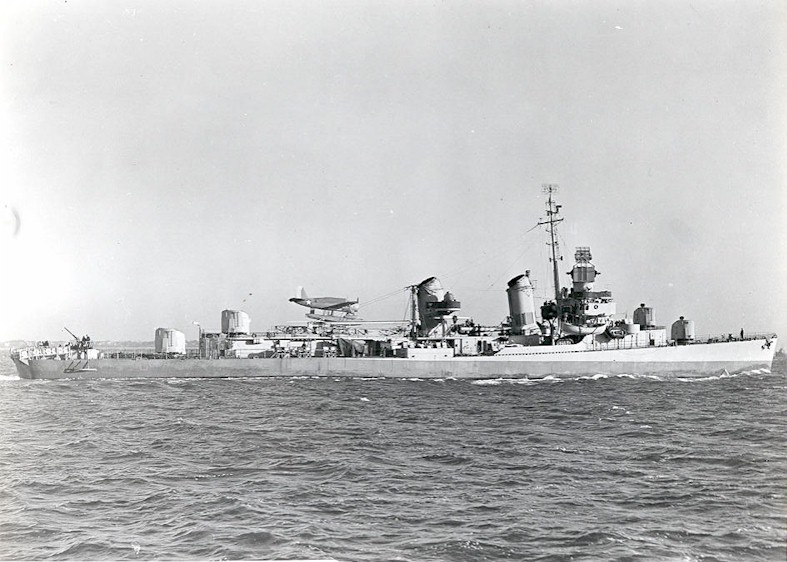
USS Pringle with her catapult as completed by December 1942, sporting a Vought OS2U Kingfisher. read more.
The ships were large enough to offer many new modifications possibilities. Three in the class received thus a catapult to operate a standard issue Vought OS2U Kingfisher observation floatplane. This was not unique to the USN. The vast expanses of the Pacific made naval aviaition vital, and the smaller Dutch destroyers of the “admiralen class” of the interwar already sported an observation plane, albeit no catapult. It was just craned down in the water for takeoff and retrieval.
The catapult was of the standard cruiser hydraulic type, installed in lieu of the aft torpedo tube bank. Only USS Pringle, Stevens, Halford received this upgrade after completion.
This was not proven successful, and they were landed by December 1943. Reasons were unstability, and just better radar coverage overall.
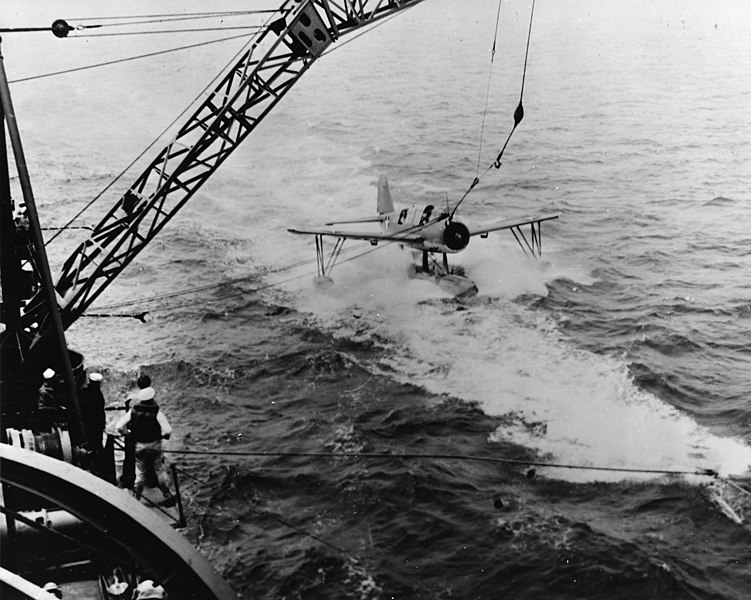
Kingfisher being recovered by USS Stevens during tests in 1943
Combat Proven: The fletchers in Action
These ships, also nicknamed “tin cans” due to their lack of protection compared to the “bid boys”, cruisers and battleships, provided by their numbers and qualities, invaluable service and missions to the USN from 1942 to 1945. Stable, they would be armed, notably with an impressively heavy AA at the end of their career given their class, providing a wall of fire to their escort, while not compromising on their ASW capabilities, nor anti-ship capabilities, a perfect balance. Although ship vs ship fights were not common, the few encounters against their peers signalled their extreme robustness in case of a hit, even of a dreaded “long lance”, but also the excellence of their main battery, well guided by top opf the line radar assisted fire control, and that their ten torpedo battery was still efficient to cause chaos among the Japanese line. By the time half were delivered for example, the numerous shortcomings of the Mark 14 torpedo had been worked out.
They were also provided better ASW depht charhe whereas more and more Bofors were added at each iteration, until by 1945 the N°3 main gun was deleted for the installation of a record 14 Bofors, two quad and three twin, while still having seven 20 mm and their AA capable four main guns.
Another role that proved their usefulness was the result of a relatively short draft, and their ability to float in just 17.5-feet of seawater. Thus, they could creep in close enough to shore to support amphibious landings from very close, seeing enemy positions with binoculars, and even dropping off commandos or helping in evacuations. Still they had somewhat longer legs than previous classes (5,500 nm unrefueled at 15-knots) so after the war they could provide gunboat diplomacy in other ports and race at 36.5-knots to check out any radar contact.
For examples, see the latter section detailing the life and deeds of some of the most remarkable in class.
Since the first ships were completed in June 1942, on 30 June for USS Fletcher. They missed the early tough battles such as the Coral Sea, and Midway, but arrived in time for Santa Cruz Island, and the whole campaign of Guadalcanal. They were present for the whole island hopping campaign that followed, the Mariannas, Marshalls, etc. with all significant battles until the last raids on Japan in 1945, escorting not only the precious and instrumental TF38/58, the mightly fast carrier fleet, but also various battleships task forces, escort carrier assault forces, and the resplenishment force, criss-crossing the Pacific from Australia, New Caledonia to the Aleutian Islands.
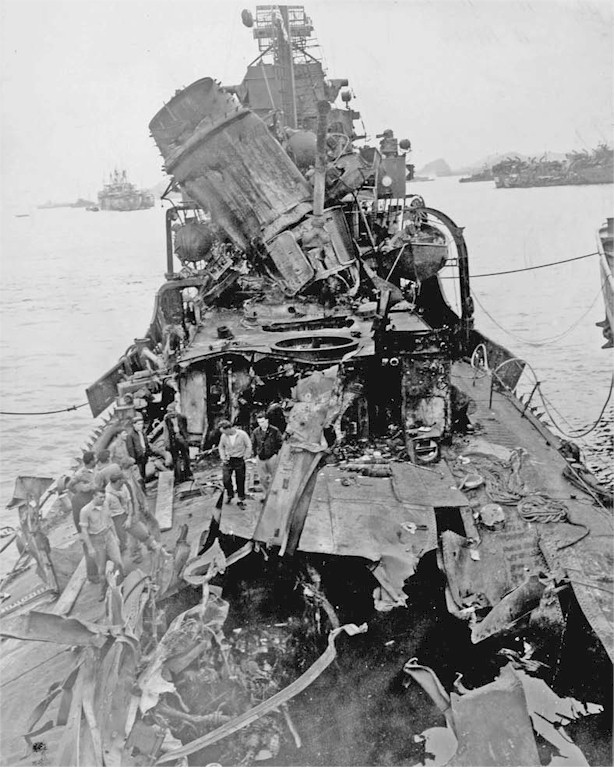
USS Newcomb’s survived a Kamikaze attack on 6 April 1945 off okinawa, like most destroyers losses in her class. The photo is self-explanatory why she was never repaired and declared instead a “total constructive loss”, even if she was still afloat. That was the fate of other ships of her class, simply towed to safety, decommissioned and placed in reserve until sold for scrap.
Their heavy involvement inevitably would cost the class a number of loss that was greater also than any other class of destroyers in the USN, but not in proportions. Earlier classes suffered way more: In all 19 were lost, plus 6 not repaired (declared total constructive losses). Many more took heavy punishment and survived, back into the fray after repairs. 19 out of 175 represents 9.2%, earlier class went up to 30% in some cases… This could reflect both their relatively late engagement, larger numbers or better resilience in general. The list belows also tells a lot about the main causes of losses and explained the direction taken for modifications in 1944-45. Compared to air attacks, there were just two lost to another ship in combat, one by a mine, one due to weather (typhoon). Kamikaze claimed more than half, especially at Okinawa, a “graveyard of destroyers” and many were claimed while on radar picket duty, precisely to spot incoming kamikaze waves…
De Haven was sunk by Japanese aircraft off Savo Island, 1 February 1943
Strong was sunk by a Japanese destroyer group operating in the Kula Gulf, 5 July 1943
Chevalier was scuttled after being torpedoed by a Japanese destroyer, accidentally rammed at the Naval Battle of Vella Lavella, 6 October 1943
Brownson was sunk by Japanese aircraft off Cape Gloucester, 26 December 1943
Hoel was sunk by Japanese surface ships in the Battle off Samar, 25 October 1944
Johnston was sunk by Japanese surface ships in the Battle off Samar, 25 October 1944
Abner Read was sunk by kamikazes in Leyte Gulf, 1 November 1944
Spence foundered in Typhoon Cobra, 18 December 1944
Halligan was lost to a mine off Okinawa, 26 March 1945
Bush was sunk by kamikazes off Okinawa, 6 April 1945
Colhoun was sunk by kamikazes off Okinawa, 6 April 1945
Pringle sunk by kamikazes off Okinawa, 16 April 1945
Little sunk by kamikazes off Okinawa, 3 May 1945
Luce was sunk by kamikazes off Okinawa, 4 May 1945
Morrison was sunk by kamikazes off Okinawa, 4 May 1945
Longshaw was scuttled after running aground and receiving heavy shore fire south of Naha, Okinawa, 18 May 1945
William D. Porter was sunk by a kamikaze off Okinawa, 10 June 1945
Twiggs was sunk by kamikazes off Okinawa, 16 June 1945
Callaghan was sunk by Yokosuka K5Y kamikaze biplanes off Okinawa, 28 July 1945
Newcomb was damaged by kamikazes off Okinawa, 6 April 1945. Decom. 20 November 1945, sold 28 March 1946.
Leutze was damaged by kamikazes off Okinawa, 6 April 1945. Decom. 6 December 1945, sold 17 June 1947.
Hutchins was damaged by a suicide boat off Okinawa, 27 April 1945. Decom. 30 November 1945. Sold January 1948.
Haggard was damaged by kamikazes off Okinawa, 29 April 1945. Decom. 1 November 1945. Sold 3 March 1946.
Evans was damaged by kamikazes off Okinawa, 11 May 1945. Decom. 7 November 1945. Sold 11 February 1947.
Thatcher was damaged by kamikazes off Okinawa, 20 May 1945. Decom. 23 November 1945. Sold 23 January 1948.
They also collected more battle stars than previous destroyer, in large part due to being a large class, but also because of their early engagement. They also sank 29 IJN submarines. Several individual ships ended as the most decorated, like USS Fletcher and USS O’Bannon, both awarded 17 battle stars and many other decorations. 44 earned 10 or more service stars, 19 the Navy Unit Commendation, 16 received the Presidential Unit Citation. They became the most decorated destroyers in US history, the signature destroyers of the Pacific war, completly eclipsing the 58 Sumner, which arrived by mid-1944 and Gearing (104) with only a few active in the Pacific when the war ended.
Upgraded Fletcher (1942), the path towards the Sumner class
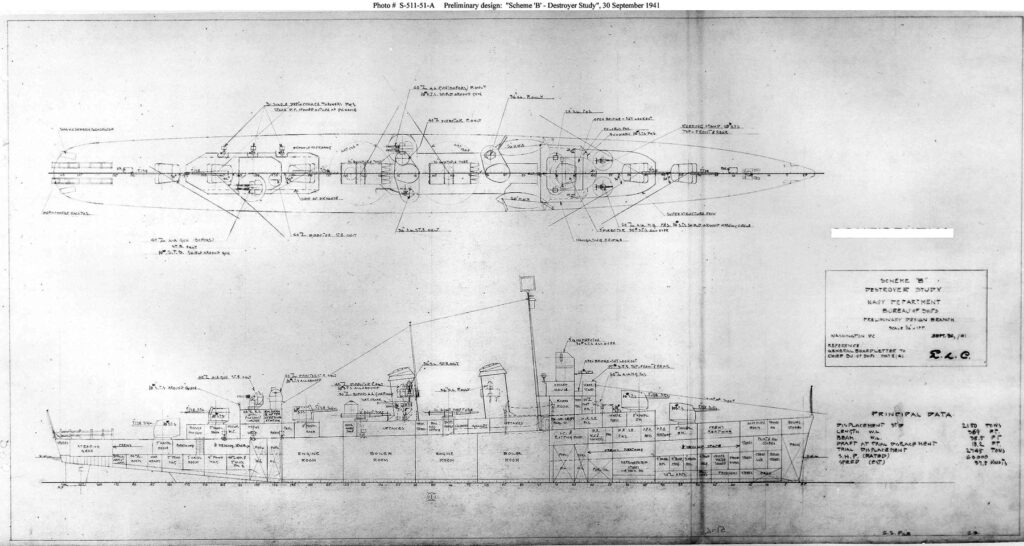
S-511-51-A “Scheme “B” – Destroyer Study” Study Preliminary design plan prepared for the General Board as part of the process leading to the Allen M. Sumner (DD-692) class design. This 30 September 1941 plan, for a 2,150-ton (standard displacement) ship, provides a slightly updated Fletcher (DD-445) class destroyer, retaining its five single 5/38 gun mounts (although two are semi-open mounts) and ten torpedo tubes. Among notable changes are a modified bridge arrangement and two twin 40mm anti-aircraft gun mounts (in place of the single quad 1.1 weapon of the original Fletchers). The original plan is in the 1939-1944 Spring Styles Book held by the Naval History and Heritage Command. U.S. Naval History and Heritage Command Photograph.
Indeed the next Sumner class as the design evolved in 1942 was to have a 20% increase of firepower, taking advantage of the new twin turrets.
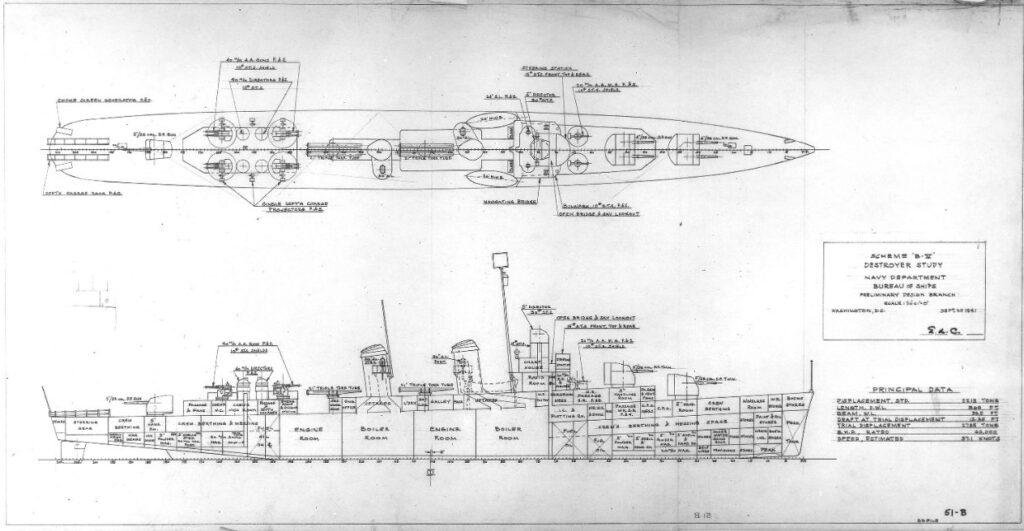
Design S-511-51-B Scheme B-V – Destroyer Study Preliminary design plan prepared for the General Board as part of the process leading to the Allen M. Sumner (DD-692) class design. This 30 September 1941 plan, for a 2215-ton (standard displacement) ship, provides two twin 5/38 dual-purpose gun mounts forward and a single 5/38 dual-purpose gun mount aft, four twin 40mm anti-aircraft guns on the after deckhouse, and two triple torpedo tube mountings. The original plan is in the 1939-1944 Spring Styles Book held by the Naval History and Heritage Command. U.S. Naval History and Heritage Command Photograph.
A remarkable career spanning many decades
All of the Fletcher underwent considerable post-war service, some heavily modernized and rebuilt, seeing the Korean and Vietnam War as well as seeing service in many allies and NATO navies until the end of the cold war. One such example is the Bundesmarine’s “Zerstörer class“, probably the most advanced of all.
Cold War Rebuilds:
Wrap around bridges, new radars, new masts, new AA: The wrap around bridges were additional bridges built in front of the ships that had the wartime simplified squared bridges. This was not possible on the early rounded bridges vessels, explaising why the latter had a shorter career postwar. Most exported ships were also of the squared bridge type. The latter had an open bridge forward of the enclosed portholed section brigde, and the new one, with large squared windows, still open to the elements on both sides, was simply built above it. This made the former bridge, alreardy dark, even darker, forcing the use of electric lighting practically at all times.
Fletchers in the Korea War
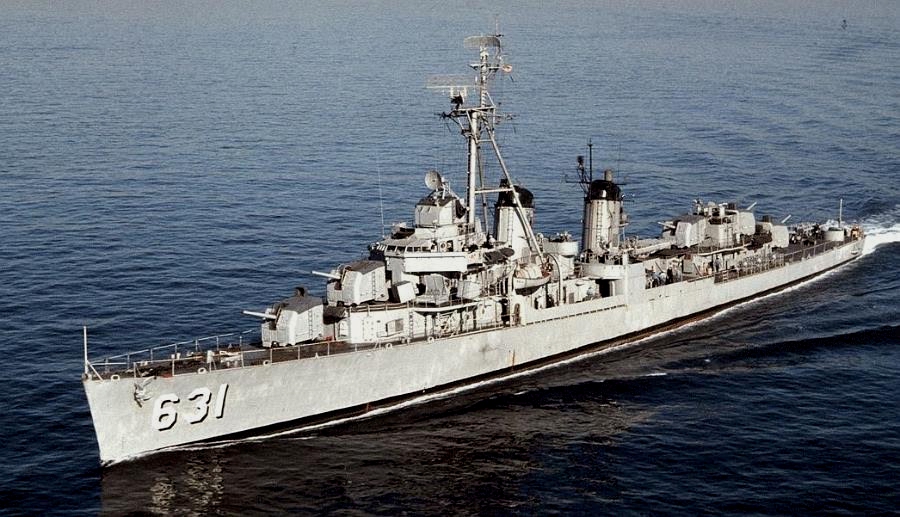
USS Erben as DD-631 in the 1950s
When the Korean War started, many destroyers (as cruisers and aircraft carriers) placed in reserve in 1946-47, were reconditioned and returned to active duty. Moreover, some 39 destroyers were refitted under project SCB 74A, as DDE (ASW specialists) conversions, with the main armament and torpedo tubes reduced in favor of a the new Weapon Alpha and extra ASW rocket launchers, trainable Hedgehogs. 18 in all were redesignated as escort destroyers (DDE) but by 1962 they were administratively reverted to the DD designation in 1962. Escorting the fleet, they showed also no lack in marksmanship when operating shore bombardments, cumulating many new battle stars.
Fletchers DDE

USS Fletcher in 1964 at Pearl Harbor
This was an extensive but still cheap ASW conversion. Displacement standard 2,325 tons, full 2,950 tons, dimensions raised to 112.5 wl 114.8m oa (), beam unchanged to 12.1 m () but draught 5.50m () max. Same powerplant, 2 sets General Electric geared steam turbines, 4 Babcock & Wilcox boilers rated for 60,000 shp however top speed reduced to 35 kts. Same range based on 492t of oil at 6,500 nm at 15 kts.
Armament was reduced to two single 5-in/38 Mk 30 fore and aft, two twin 76/50 Mk 33, four twin 20mm/70 Mk 24, a single 21-in TT bank, but also one Weapon Alfa Mk 108 ASWRL instead of N°2 superfiring turret, and two 24 tubes 178 Hedgehog Mk 11 ASWRL installed on either side of the bridge forward, angled slightly outwards.
Later ships were upgraded to a new TT banks, quintuple but firing the new TT heavy torpedo type. ASW was reduced to a single 24 tubes (178mm) Hedgehog Mk 15 ASWRL instead of the Weapon Alfa and still kept their two Hedgehog Mk 11 ASWRL, while the stern received six DCT and 2 DCR.
Fletchers FRAM II
Overall specs did not changed compared to the DDE conversions, but armament was now as standard two single 5-in/38 Mk 30 (same N°1 and 5 mounts) but two side single 21-in Mk 23 TT, and two triple 324 Mk 32 ASW TTs, single Weapon Alfa Mk 108 ASWRL, and the same two 24 Hedgehog Mk 11 ASWRL as before while the aft section received a platform for a DASH drone helicopter. They were less successful than the Sumner FRAM II.
In foreign service
 Lanciere class (1969-1980)
Lanciere class (1969-1980)
DD468 USS Taylor to Italy 7.1969 (Lanciere)
DD517 Walker to Italy 7.1969 (Fante)
DD561 Prichett to Italy 1.1970 (Geniere)
 Para class (1959-1979)
Para class (1959-1979)
DD472 USS Guest to Brazil 6.1959 (Pará)
DD473 Bennett to Brazil 12.1959 (Paraiba)
DD556 Hailey to Brazil 7.1961 (Pernambuco)
DD596 Shields to Brazil 7.1972 (Maranhão)
DD675 Lewis Hancock to Brazil 8.1967 (Piauí)
DD794 Irwin to Brazil 5.1968 (Santa Catharina)
DD797 Cushing to Brazil 7.1961 (Parana)
 Zerstörer class (1958-1987)
Zerstörer class (1958-1987)
DD515 Anthony to West Germany 1.1958 (Z1)
DD500 Ringgold to West Germany 7.1959 (Z2)
DD516 Wadsworth to West Germany 10.1959 (Z3)
DD571 Claxton to West Germany 12.1959 (Z4)
DD572 Dyson to West Germany 12.1960 (Z5)
DD570 Charles Ausburne to West Germany 4.1960 (Z6)
 Lapanto class (1957-1980)
Lapanto class (1957-1980)
DD509 Converse to Spain 7.1959 (Almirante Valdéz)
DD550 Capps to Spain 5.1957 (Lepanto)
DD551 David W. Taylor to Spain 5.1957 (Almirante Ferrándiz)
DD678 McGowan to Spain 11.1960 (Jorge Juan)
DD799 Jarvis to Spain 11.1960 (Alcalá Galiano)
 Guise class (1960-1985)
Guise class (1960-1985)
DD520 Isherwood to Peru 12.1960 (Almirante Guise)
DD796 Benham to Peru 10.1961 (Villar)
 An Yang class
An Yang class
DD521 Kimberly to Taiwan 6.1967 (An Yang)
DD528 Mullany to Taiwan 10.1971 (Chiang Yang)
DD540 Twining to Taiwan 10.1971 (Kwei Yang)
DD541 Yarnall to Taiwan 6.1968 (Kuen Yang)
 Almirante brown class (1961-1980)
Almirante brown class (1961-1980)
DD532 Heermann to Argentina 8.1961 (Almirante Brown)
DD547 Cowell to Argentina 8.1961 (Almirante Storni)
DD644 Stembel to Argentina 8.1961 (Rosales)
DD630 Braine to Argentina 8.1961 (Domecq García)
DD670 Dortch to Argentina 8.1961 (Espora)
 Istanbul class (1967-1990)
Istanbul class (1967-1990)
DD544 Boyd to Turkey 10.1969 (İskenderun)
DD651 Cogswell to Turkey 10.1969 (İzmit)
DD656 Van Valkenburgh to Turkey 2.1967 (İzmir)
DD668 Clarence K. Bronson to Turkey 1.1967 (İstanbul)
DD795 Preston to Turkey 11.1969 (İçel)
 Velos class (1959-1985)
Velos class (1959-1985)
DD545 Bradford to Greece 9.1962 (Thyella)
DD546 Brown to Greece 9.1962 (Navarino)
DD569 Aulick to Greece 8.1959 (Sfendoni)
DD581 Charrette to Greece 6.1959 (Velos)
DD582 Conner to Greece 9.1959 (Aspis)
DD583 Hall to Greece 2.1960 (Lonchi)
 Cuauhtémoc class (1968)
Cuauhtémoc class (1968)
DD573 Harrison to Mexico 5.1968 (Cuauhtémoc)
DD574 John Rodgers to Mexico 5.1968 (Cuitláhuac)
 Chungmu class (1963)
Chungmu class (1963)
DD631 Erben to South Korea 5.1963 (Chungmu)
DD673 Hickox to South Korea 11.1968 (Pusan)
DD686 Halsey Powell to South Korea 4.1968 (Seoul)
 Blanco Encalada class (1962)
Blanco Encalada class (1962)
DD689 Wadleigh to Chile 7.1962 (Blanco Encalada)
DD804 Rooks to Chile 7.1962 (Cochrane)
 Antioquia (1962)
Antioquia (1962)
DD642 Hale to Columbia 12.1960 (Antioquia)
 Ariake class (1959)
Ariake class (1959)
DD663 Heywood L. Edwards to Japan 3.1959 (Ariake)
DD664 Richard P. Leary to Japan 3.1959 (Yugure)
Preserved Ships
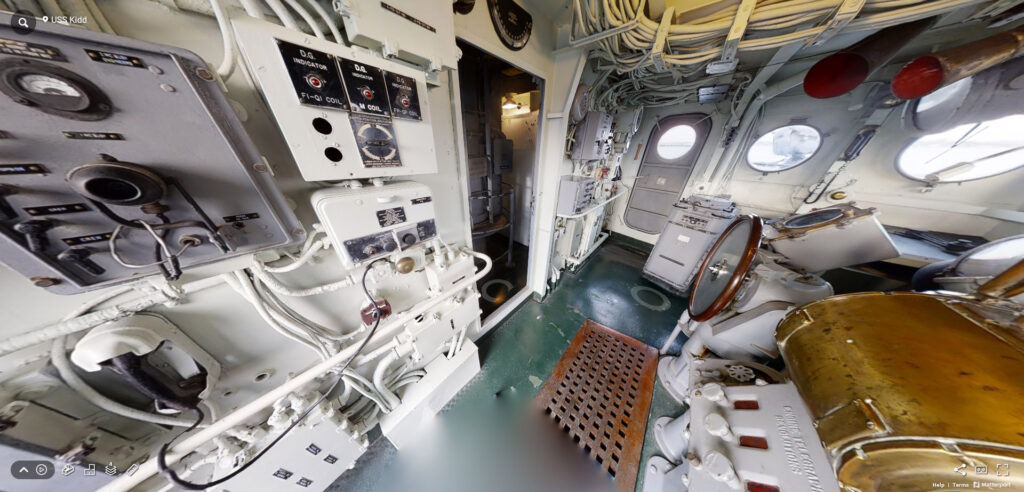
The USS Kidd’s website integrates a nice 3D visit (so if you have a virtual headset, go for it) before seeing the real one in person, especially if like me you live outside the US.
USS The Sullivans (DD-537), in Buffalo, New York.
USS Kidd (DD-661), in Baton Rouge, Louisiana.
USS Cassin Young (DD-793), in Boston, Massachusetts.
Velos (D16), in Palaio Faliro, Greece.
Read More
Books
Bauer, K. Jack; Roberts, Stephen S. (1991). Register of Ships of the U.S. Navy, 1775–1990: Major Combatants. Greenwood Press
Davis, Rick E. & Wright, Christopher C. (2010). “USN Aircraft-Handling Destroyers 1919 to 1943, Part I: 1919–1941”. Warship International
Friedman, Norman (2004). US Destroyers: An Illustrated Design History (Revised ed.). NIP
Gardiner, Robert; Chesneau, Roger (1980). Conway’s All the World’s Fighting Ships 1922–1946. Conway Maritime Press.
Gardiner, Robert; Chumbley, Stephen (1995). Conway’s All the World’s Fighting Ships 1947-1995. Conway Maritime Press.
Silverstone, Paul H. (1965). U.S. Warships of World War II. London: Ian Allan Ltd
Toby, A. Steven (2015). “Note on High Speed Destroyers’ Maneuverability”. Warship International.
Links
navyhistory.org life-on-a-fletcher-class-destroyer-1950s
pwencycl.kgbudge.com/ Fletcher_class
laststandonzombieisland.com/tag/fletcher-class/
history.navy.mil/ fletcher.html
destroyerhistory.org fletcherclass/
dd793.com USSCassinYoung.html
navyhistory.au the-fletcher-class-destroyers/
radartutorial.eu/
en.wikipedia.org Fletcher-class_destroyer
navypedia.org/ us_dd_fletcher.htm
history.navy.mil uss-fletcher–dd-445-dde-445–0.html
ussfletcher.org/
navsource.org/ DD445.htm
destroyerhistory.org/fletcherclass/ussfletcher/
history.navy.mil/ fletcher.html/
https://web.archive.org/web/20040716222424/http://www.destroyersonline.com/usndd/dd445/dd445pho.htm
wikipedia.org List_of_Fletcher-class_destroyers
Fletcher-class Destroyer U.S.S. Capps later Spanish destroyer Lepanto
Videos
Model Kits
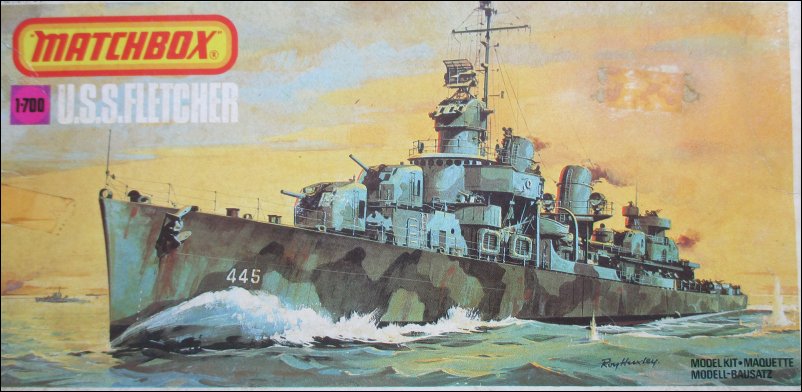
Matchbox’s USS Fletcher 1:700. Not the finel crafted of kits, but i did this one as a kiddo.
General Query on scalemates.. It should not be a surprise. The Fletcher class given their importance was relatively well covered by model kit manufacturers: The largest goes to Aquacraft, a limited RC model at 1/72. As for “yard models”, USS Kidd DD-661
was proposed by Deans Marine at 1:96. Then came classic plastic kits of the gold years of the 50-60-70s, Lindberg’s 1:125, Revell’s 1:144, Bluejacket Ship Crafters 1:192, Digital Navy 1:200 (a 2015 paper kit), Modelik 1:200, Progresswerk Nürnberg 1:200, Trumpeter 1:200, Revell 1:301, Aurora 1:306, Blue Water Navy 1:350, Iron Shipwrights/Tamiya/Trumpeter/Yankee Modelworks 1:350, Aurora 1:600, Hawk/Testor 1:670 and a flurry of 1:700 from AMT, Green Max, Matchbox, Pit-Road, ROP o.s. Samek Models and the usual suspects seen above, Revell, Tamiya, Trumpeter. And there are the also usual tabletop gaming 1:1200 models or under by Atlantis, Hansa, Renwal, XP Forge, Navis – Neptun 1:1250, C-Mac Models 1:2400. For very large 1:48 static/RC models, there are also a large choice of 3D or classic platic parts, bridges, guns, etc from Model Monkey or CNC, the scale shipyard, as well as photo-etch plates. Books for modelling the Fletcher are found above.
World Of Warship’s USS Kidd, detail’s galore
3D
The Fletcher class destroyers in service

Notice: Given the enormity of the class (175 hulls) i will not dwelve into detail in the career of each of them, and instead pick up some remarkable examples, the most decorated or outstanding ships of the class. I will also cover the cold war career of each one, at least under US flag.
 USS Fletcher, class lead ship (DD-445)
USS Fletcher, class lead ship (DD-445)
Pacific WW2 service
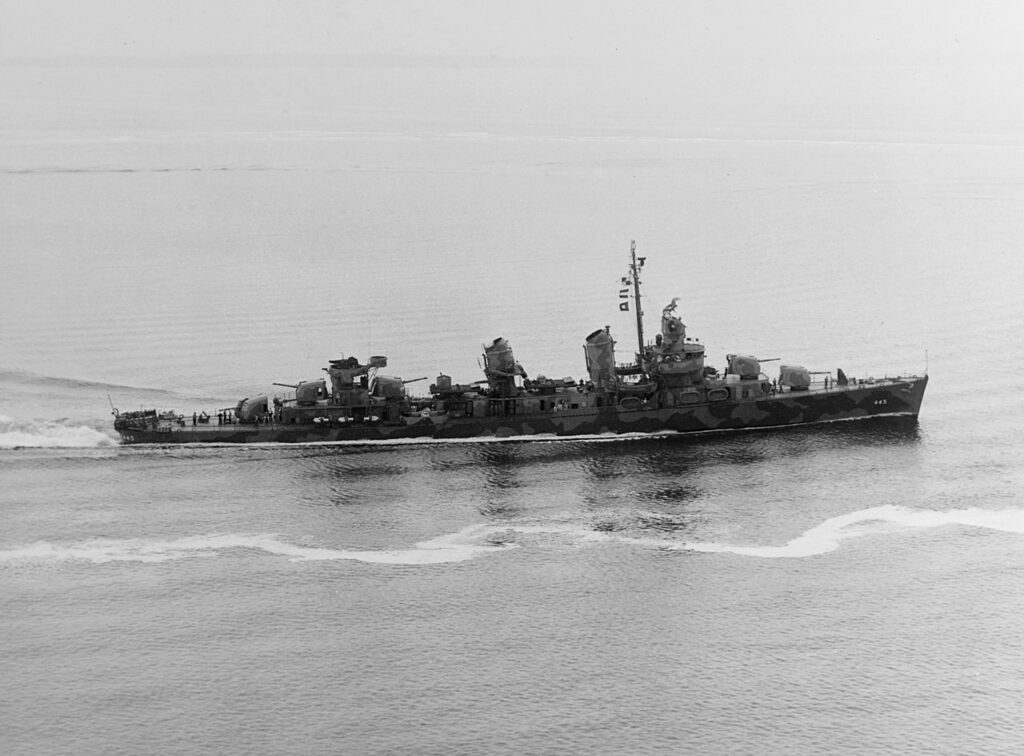
USS Fletcher (DD/DDE-445) was laid down at Federal Shipbuilding and Dry Dock Co., Kearny, New Jersey, on 2 October 1941. Launched on 3 May 1942 she was commissioned on 30 June 1942. After shakedown training in home waters, West Coast, from New England to the Carribean, she transited in September via the Panama Canal to San Diego and from there, to Pearl Harbor. After quick training in Hawaiian waters, she was sent for the south Pacific, taking part in the Guadalcanal and Solomons operations. She arrived at Nouméa in New Caledonia on 5 October 1942 and started immediately escort and patrol. She performed her first combat mission with artillery when bombarding Lunga Point on 30 October. From Espiritu Santo on 9 November she sailed to cover landing on Guadalcanal and drove off an enemy air attack on 12 November, claiming several shot down. Next she was caught in the Naval Battle of Guadalcanal, and was present during the action of 13 November, firing guns and torpedoes and probably co-claimed one of two Japanese destroyers, also damaging IJN Hiei, later finished off.
Fletcher replenished at Espiritu Santo and sent back for escorts and patrols off Nouméa. On 30 November 1942, she departed with a force to intercept a Japanese “Tokyo Express” convoy. USS Fletcher led the force through Lengo Channel and so was the first to make radar contact. This soon became the Battle of Tassafaronga. She did her part and rescued survivors of USS Northampton using her cork-floated cargo nets. Operations went on in the Solomons with occasional shore shelling missions and driving off air attacks as well as SAR missions of downed aviators, and sinking occasional IJN barges. She also covered landings on the northern coast of Guadalcanal. On 11 February 1943 she spotted a smoke float dropped by a plane from USS Helena, which was the position of IJN submarine I-18, that she sank. Next she covered landings on the Russell Islands (21 February) and shelled Munda airfield (New Georgia) on 5/6 March.
From 23 April to 4 May 1943 she had a refit in Sydney and well deserved crew’s leave. Back to Espiritu Santo she sailed out on 19 June for her major west coast overhaul and back to Nouméa on 27 September, back in the Solomons on 31 October. She joined on of the TF 38 aircraft carrier task forces fpr the invasion of the Gilbert Islands, and drove off an air atack on 26 November 1943 and 4 December while off Kwajalein.
Back to Pearl Harbor on 9 December 1943 she had a brief overhaul, training on the west coast and she was back in the Marshall Islands, screening troop transports from San Diego to Lahaina Roads until 21 January 1944 and covered a bombardment group on Wotje Atoll, 30 January. Next she covered the landings on Kwajalein and patrolled until 4 February. She escorted them back to Funafuti, and sailed to Majuro on 15 February forscreening battleships en route to Taroa and Wotje (20-21 February) also patrolling off Eniwetok.
After training off Port Purvis, Florida Island (Solomons) she went to Cape Sudest (New Guinea) on 18 April as a base for a month of constant operations: Humboldt Bay landings, reinforcement landings, escort to Nouméa, ASW patrols into May, and back to Humboldt Bay on 5 June. She also took part to shore bombardments at Noemfoor, Sansapor, and Morotai, and more patrols until September.
In Manus on 9 October 1944 she was prepared for the invasion of Leyte on 12 October, also screening transports and the landings on 20 October. She was back to New Guinea and missed the Leyte battle. She was back to Leyte on 23 November, and took part in the liberation of the Philippines, shelling Ormoc Bay and Mindoro, repelling air attacks.
On 4 January 1945 she departed San Pedro Bay for covering Luzon Attack Force, repelling several air attacks notably on 8 January, covered the landings in Lingayen Gulf and those on San Antonio Beach (Luzon) and on 29 January entered Subic Bay to protected the minesweepers. On 31 January she covered landings in Nasugbu Bay. Next she took part in the occupation of Bataan and Corregidor (13 February) and was stationed for support call, covering minesweepers into Manila Bay. On 14 February while silencing the Japanese battery at Los Cochinos Point, she took a hit (8 kia, 3 wounded). Later she performed a rescue operations for YMS-48. Elmer C. Bigelow was posthumously awarded the MoH (Medal of Honor) for “conspicuous gallantry and intrepidity” and continued operations in Manila Bay until the 17th.
Fletcher took part in the landings at Puerto Princesa (Palawan) as well as Zamboanga and covered minesweeping and landings at Tarakan. He escorts and patrols went on throughout the Philippines until 13 May 1945, and departure for the West Coast for an overhaul. After exercises off San Diego and Hawaii she stayed in San Diego in reserve on 7 August 1946, decommission on 15 January 1947. But this was not the end of her career, far from it.
Cold war service
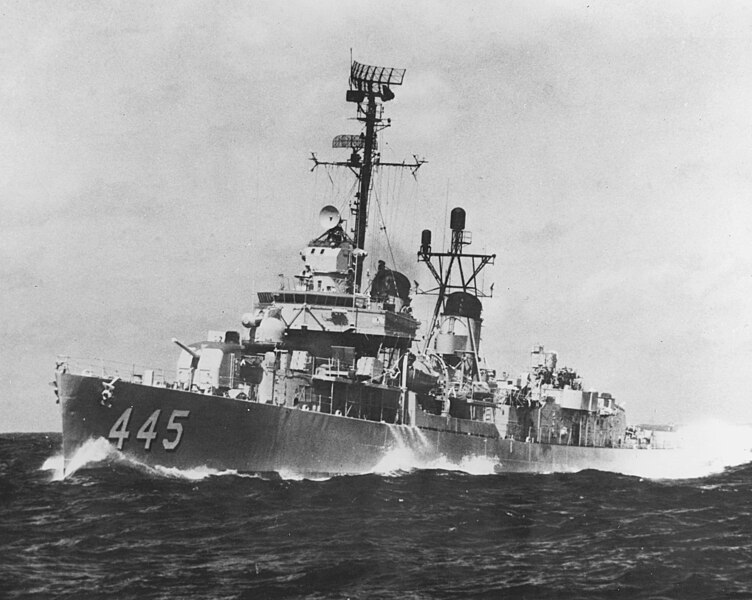
Recommissioned 3 October 1949 she was reconditioned and rearmed as a DDE conversion, specialist in ASW and redesignated DDE-445. She left San Diego on 1 May 1950 and returned in the Pacific, meeting the 7th Fleet. Soon the Korean War broke out and she teamed up with USS Valley Forge at Hong Kong. On 3 July she started her combat patrols off Korea and soon Valley Forge was joined by HMS Triumph, starting airstrikes. She only left the area for resplenishement in Buckner Bay (Okinawa) and later Sasebo in Japan. She was present for the Battle of Inchon on 13-17 September and returned for an overhaul at Pearl Harbor on 11 November. By 19 November 1951 she left for another TOD in Korea. Again she screened more carriers of the 7th Fleet and had occasions of shore bombardment, cut by ASW training. She also patrolled in the Taiwan Straits and was back to her homeport at Pearl Harbor on 20 June 1952. She departed on 5 September up to 24 November taking part in Operation Ivy. Back to Pearl she sailed again for a last TOD between 14 May to 30 November 1953 off Korea.
She went on in service with the 7th fleet yearly from 1954 to 1962. In 1955 she screened the fleet evacuating the Tachen Islands. In 1957-1958, she made a passage to Samoa and Australia. Intensive ASW training had her staying at the top of her game in very tense situation, notably during the Cuba crisis and beyind.
After many years of service she was eventually decommissioned, stricken on 1 August 1969, sold on 22 February 1972.
In addition to her 15 battle stars for WW2 and 5 battle stars for Korea, she was awarded the Korean Service Medal with five battle stars, Philippine Presidential Unit Citation, Korean Presidential Unit Citation, Philippine Liberation Medal with two stars, and United Nations Service Medal.
 USS Nicholas (DD 449), Most Decorated
USS Nicholas (DD 449), Most Decorated
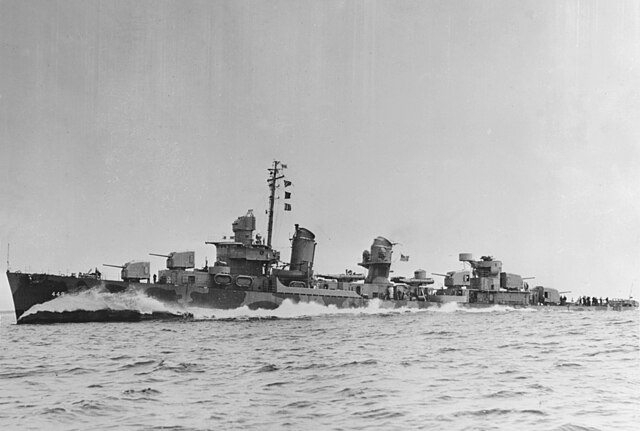
Forever linked to O’Bannon in probably the most iconic Fletcher class combat in WW2, USS Nicholas had the same amazing 27+ years spanning career from Guadalcanal to Vietnam. was laid down 3 March 1941 by the Bath Iron Works Corp. in Bath, Maine, launched 19 February 1942 and commissioned 4 June 1942.
“Nick”‘s Pacific War
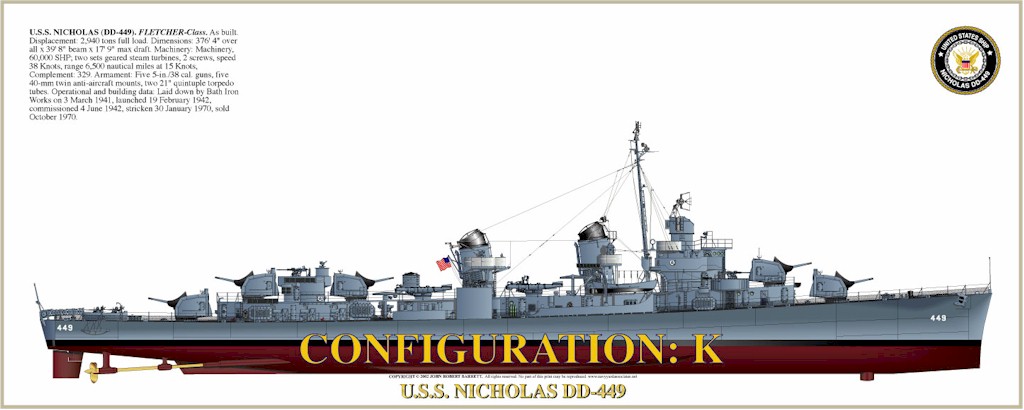
Profile of USS Nicholas as completed, by graphic illustrator John Barrett with the text written by naval author and historian Robert F. Sumrall. Source www.navsource.org (wikimedia CC)
Assigned for the Pacific for all of her career, USS Nicholas was assigned to Destroyer Squadron 21 (DesRon 21), departing NyC on 23 August 1942 escorting USS Washington (BB-56) through the Panama Canal, and Central Pacific, Espiritu Santo on 27 September. Se sailed to Guadalcanalwith a convoy and throughout 1943 screened the convoys assembled at Espiritu Santo and Nouméa to Guadalcanal and Tulagi, sometimes detached for antisubmarine hunter-killer missions and dangerous missions in “the Slot”, bombarding Japaneese positions on shore, supporting Marine and Army units pushing to Tenamba River.
In January she was based at Tulagi, the “Cactus Striking Force” (Task Force 67), repelling a last IJN counterattack and destroying Munda airfield and cutting the Kokumbona-Cape Esperance escape route. On 1 February Operation KE (evacuation of Guadalcanal) saw USS Nicholas covering the 2nd Battalion, 132nd Infantry landing at Verahue, in order to cutoff the Cape Esperance area. With USS De Haven (DD-469) and 3 LCTs she was attacked by 14 Aichi D3A “Val” dive bombers, De Haven receving three bombs hit and near miss, sinking rapidly. Nicholas downed eight and only had a near miss (2 KiA) with her steering gear damaged.
Following repairs, Nicholas went on between Escort and bombardments missions, to the Munda-Kolombangara area (New Georgia) in March, joined TF 18 the next month for the “Slot” patrol and was in at Sydney, with her crew resting. She departed on 11 May and sailed with TF18 to Kolombangara. On the 13th, her #3 gun jammed and exploded, she ws repaired at Nouméa and was back to the Solomons-New Hebrides area. On 5 July she shelled Kolombangara and took part in the battle of Kula Gulf. She rescued survivors of USS Helena (CL-50) and for her gallant fight she and Radford (DD-446) were awarded the Presidential Unit Citation, Admiral Chester Nimitz later telling the crew “the respect and esteem which this ship, her officers and men have well earned throughout the Navy.”
12th-13th saw her taking part in the Battle of Kolombangara and after a run to Vella LaVella returned to Tulagi for more escort missions. In August she joined TU31.5.1, covered the landings at Barakoma. Later she departed Tulagi again with O’Bannon (DD-450), Taylor (DD-468), and Chevalier (DD-451) to intercept four Rabaul-based Japanese destroyers (Sazanami, Hamakaze, Isokaze, Shigure, RaDM Matsuji Ijuin) trying to evaluate 9,000 troops, escorting 13 Daihatsu-class landing craft, 4 motor torpedo boats and 2 subchasers, 2 armored Daihatsus, and a Soukoutei-class armored boat. They were metby night in the “Slot” by radar at 00:29 on 18 August. The Japanese “crossed the T” of the destroyers and eventually Isokaze was hit and subchasers Cha-5 and Cha-12 sunk as well as 2 MTBs and a Daihatsu. Later on 19-20 August was in barge hunts and by 24-25th covered minesweepers. After a stop at Nouméa she started operations against New Guinea and Australia and the Solomons in October, covering landings at Barakoma and sailing to Efate.
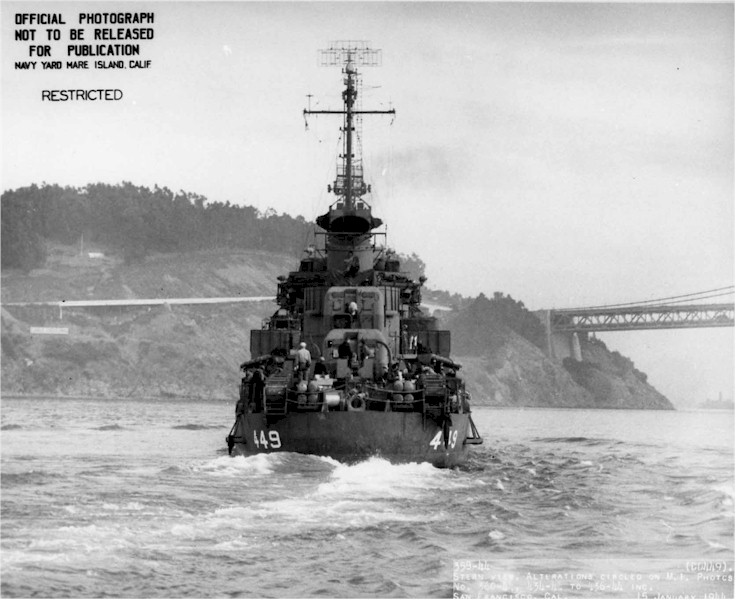

USS Nicholas on 15-17 January 1944 and arriving San Francisco and during the Mare Island overhaul.
On 11 November she departing the assembling area in the Fiji Islands joining TG50.1 for raids on Kwajalein and Wotje and retired to San Francisco on 15 December for overhaul. 12 February 1944 saw her back in the South Pacific, back with DesRon 21, stationed at Milne Bay for the 7th Fleet. She covered the Aitape landings, escorted resupply groups to Humboldt Bay, joined the 3rd Fleet off New Ireland, and back to the 7th Fleet, TG70.8 for the northern Solomons campaign. On 15 August 1944 she jouned at Manus Island TF74 to serve along the New Guinea coast and supported the Morotai landings on 15–30 September.
On 18 October, assigned to TG 78.7 she escorted reinforcements to Leyte, patrolled off Dinagat Island and back to Manus. On 8 November she went to Ulithi and Kossol Roads and with USS Taylor and escorting USS St. Louis (CL-49) on 12 November they spotted a submarine and eventually sank I-38. Later with TG77.1 she patrolled the Leyte Gulf until 6 December, repelling four Kamikaze attacks along the way, making a sweep of the Camotes Sea, shelling Ormoc Bay, covering landings. She made another escort from Manus to Leyte.
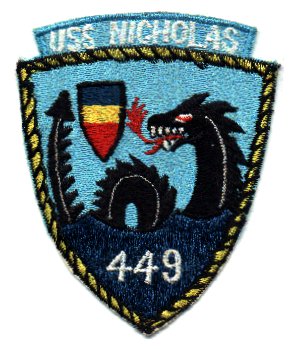 By January 1945 she joined TG77.3 (Close Support Group, Lingayen Operation). En route to Luzon she spotted and sunk enemy midget submarines and repelled air raids. After providing fire support at Lingayen, she patrolled west of Luzon and on the 24th captured a MTB escaping from the island; She covered later the landings in Zambales.
By January 1945 she joined TG77.3 (Close Support Group, Lingayen Operation). En route to Luzon she spotted and sunk enemy midget submarines and repelled air raids. After providing fire support at Lingayen, she patrolled west of Luzon and on the 24th captured a MTB escaping from the island; She covered later the landings in Zambales.
In February she escorted ships betwee, Leyte and Mindoro, proceeded to Manila Bay, shelling Corregidor, entered Manila Bay, shelled Mariveles. She guarded minesweepers in Basilan Strait, supported the occupation of Zamboanga. In April she was off Luzon called for close support of the 6th Army and patrolled in the Netherlands East Indies. Until 5 May she was at the Tarakan operation. Back to Luzon and Leyte she joined TU30.12.2 departing for Okinawa on 15 June. After Sakishima, she joined TG30.8 at Ulithi, covering the resplenishment area. On 11 August she was assigned to CTG38.4 fast carrier task group, screening their raid on the Tokyo area until V-Day on 15 August.
She was invited by Admiral William Halsey, CiC 3rd Fleet (TF 38) with USS O’Bannon and Taylor to escort USS Missouri in Tokyo Bay for the Japanese surrender ceremony “because of their valorous fight up the long road from the South Pacific to the very end.” U.S.S. Nicholas in fact had the honor of being the very first USN ship to enter Tokyo bay. “Nick” became Flagship, transporting Allied and U.S. representatives on Missouri on 2 September and later took part in “Magic Carpet” missions. She arrived at Seattle, pressed on to San Pedro on 1 November and inactivation.
USS Nicholas’s Korean War
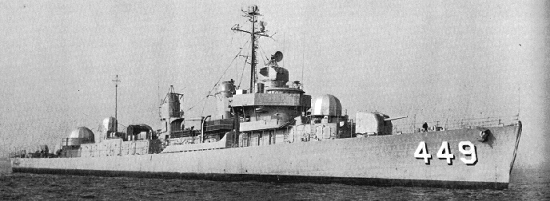
Decommissioned on 12 June 1946, Pacific Reserve Fleet she was taken in hands for DDE conversion as DDE-449 on November 1949 until February 1951. After shakedown off the west coast she joined at Pearl Harbor CortDesDiv 12 and CortDesRon 1 sailing to the Western Pacific and Yokosuka on 10 June. She screened carriers of TF77 off Korea and patrolled between Yokosuka and Okinawa as well as the Taiwan Strait. On 3 May 1952 she sailed from Pearl Harbor for Korea, second TOD with DesDiv 112 and TF77, taking the gun line under CTF95 until July. She made a third Korea TOD with CortDesDiv 12 by November until 20 May 1953. Next she was in stabdard WestPac exercize routune with the 1st Fleet and later 7th Fleet from Japan to Sumatra, and EastPac from Hawaii to the west coast. She also took part in the attomic tests, Operation Castle.
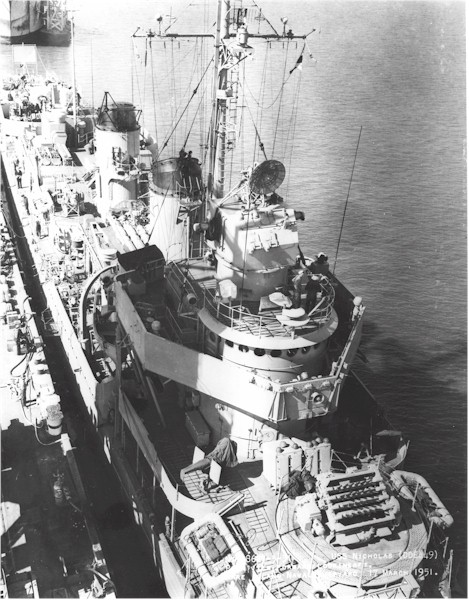
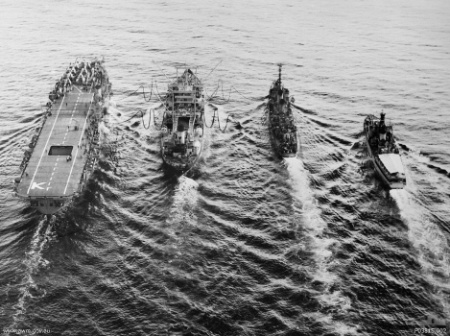
Escorting HMAS Sydney off Korea
USS Nicholas’s Vietnam War
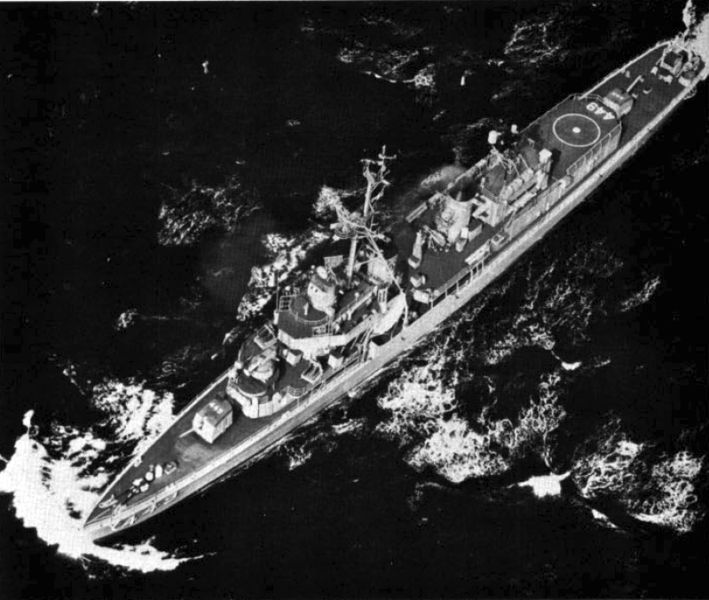
USS Nicholas in 1962 after her GRAM II conversion
After several routine years post-Korea she underwent her Fleet Rehabilitation and Modernization (FRAM) between December 1959 and July 1960, taking part in her WestPac, duties back to the South China Sea. DD-449 from 1 July 1962, she returned in the China sea by March 1965, engaged in Operation Market Time along the South Vietnamese coastline. She woould return in Viet Nam by mid-September between surveillance and gunfire support, then patrolling off Taiwan. By 1966 she made a third Viet Nam TOD on “Yankee Station”, Gulf of Tonkin, and another “Market Time” patrol. After a stop and rest to Australia she proceeded to Hawaii in March. Next years saw her in WestPac tour, gunfire support in late 1966 to May 1967 and Operation Deckhouse Five where she patrolled the Mekong Delta and DMZ. She made yet another TOD in 1968 mostly “Yankee Station” and gunline.
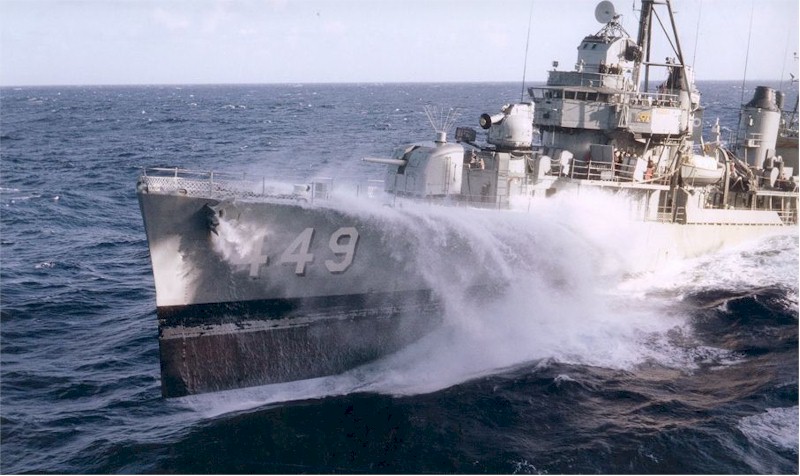
USS Nicholas in heavy seas, 1968
She made an EastPac TOD in 1968, taking part in NASA’s space capsule recovery missions, notably Apollo 8. She later made another Western Pacific cruise and by 30 January 1970, she was now the oldest active US destroyer, being decommissioned in a ceremony at Pearl Harbor with O’Bannon. After towed to Portland she was BU in 1972, among the last 7 Fletchers in service.
Her Presidential Unit Citation stated:
For outstanding performance in action against enemy Japanese forces off Kolombangara Island, New Georgia Group, Solomon Islands, on the night of July 5–6, 1943. After waging a vigorous battle as part of the small Task Force which destroyed a superior Japanese surface force, the NICHOLAS remained behind with an accompanying destroyer to save the survivors of the torpedoed U.S.S. HELENA. Forced to clear the area on three occasions during rescue operations, she gallantly fought off continuing attacks by Japanese warships emerging from Kula Gulf and, with the other destroyer, sank or damaged an enemy light cruiser and two destroyers with deadly torpedo and gunfire, returning to the area after each onslaught to complete the heroic rescue of more than seven hundred survivors. The valorous achievements of the NICHOLAS reflect great credit upon the United States Naval Service.
In addition to 16 battle stars for WW2 only surpassed by USS O’Bannon she earned 5 more in the Korean War, 9 for the Vietnam War for 30 total, making her the most decorated ship in US history so far.
 USS O’Bannon: The three wars vet’ (DD 450)
USS O’Bannon: The three wars vet’ (DD 450)
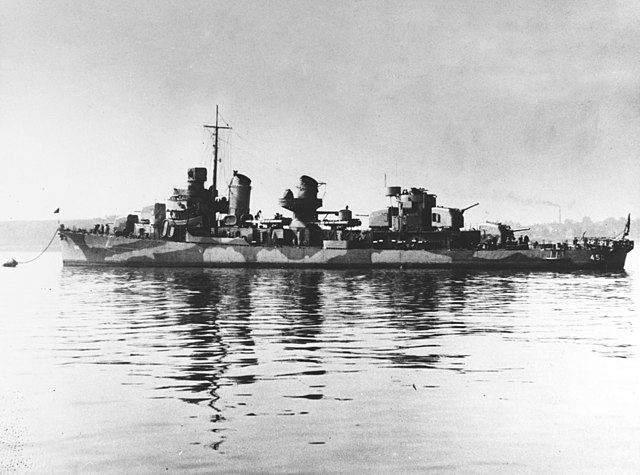
USS O’Bannon in 1942
Among all ships of the class, USS O’Bannon was probably among the most famous. She not only soldiered in WW2, completed the third after USS Fletcher, taking all the significant campaigns of the Pacific, but the Korean war as well, and even the Vietnam War, with several tour of duties for each. Admiral Halsey will say about her:
The history of the Pacific war can never be written without telling the story of the U.S.S. O’Bannon. Time after time the O’Bannon and her gallant little sisters were called upon to turn back the enemy. They never disappointed me.
O’Bannon’s Pacific Campaign 1942-45
O’Bannon was laid down at Bath Iron Works Corp. in Maine on 3 March 1941, launched 19 February 1942, first with USS Nicholas (DD-449) of the class to be launched. Sh was commissioned at Boston on 26 June 1942, briefly trained in the Caribbean, making an express shakedown cruise and sailed from Boston on 29 August 1942 for the Pacific via Panama, San Diego, Pearl Harbor. Her first assignation was the Solomon Islands campaign, supporting the Marine Corps and Army assigned to DesRon 21. O’Bannon would eanr for this campaign a Presidential Unit Citation.
She started operations like others from Nouméa, New Caledonia, escorting the CVE USS Copahee to Guadalcanal, enabling on 9 October, 20 Marines to flew their Grumman F4F Wildcats to Henderson Field, bringing some oxygen. O’Bannon roamed the New Hebrides and southern Solomons in escort and by 7 November was assigned to RADM Daniel J. Callaghan’s Support Group.
While screening the fleet off Guadalcanal, she spotted a surfaced enemy submarine, and fired, then track her down so the convoy could pass on. On 12 November she was escorting the now unladen transports when a wave on 16 enemy torpedo bombers fell on them, but she shot down 4 our of 11 that day.
On 13 November she fought at Ironbottom Sound, boldly attacking the IJN Hiei, closing in such a way the latter could not depress her gun low enough to hit her, so she could deliver her torpedoes while her gunners accurattly targeted by gunfire the fast battleship’s bridge. She launched at Hiei point blank her full broadside, eight torpedoes, with two hitting, and earning another citation for the 1st Naval Battle of Guadalcanal.
 Until October 1942 she went on covering landings, escorting troopships to and from Nouméa and Espiritu Santo to Guadalcanal and Tulagi alternated with shore bombardments missions.
Until October 1942 she went on covering landings, escorting troopships to and from Nouméa and Espiritu Santo to Guadalcanal and Tulagi alternated with shore bombardments missions.
But there is a strange story in her career, called the “Potato Incident”.
In April she sighted a Japanese submarine surfaced and opened fire, but the latter closed in so far as she could not depress her gun low enough to hit her. The story then went to say that the few sailors present on deck had nothing to throw at her but potatoes, directly attacking the Japanese crew now on deck with these unusual projectiles. Commander Donald MacDonald had his own version, saying this was the cook that, on deck to see the encounter, believed that he could throw a potato at the sub. But despite later denials, the story of a Japanese submarine sunk with potatoes was too good not to be picked up by the media and spread throughout navy lore…
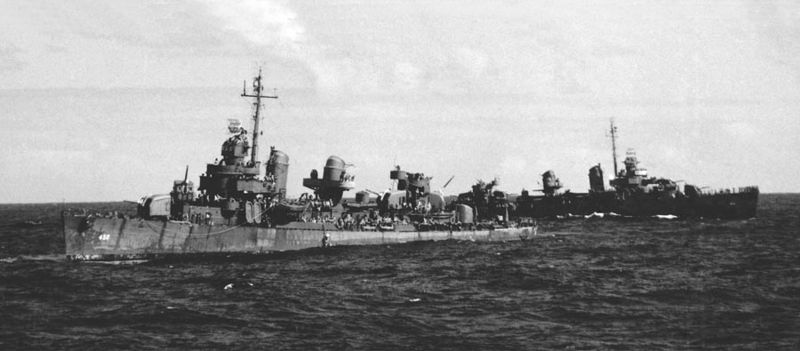
USS O’Bannon and Chevalier in July 1943, before the battle of Kula Gulf
More seriously O’Bannon too later part of the Battle of Kula Gulf (6 July 1943), screening three cruisers and three other destroyers against ten Japanese destroyers. She later took part in the Battle of Kolombangara and remained unscaved from both, whereas liberally spending her ammunitions and torpedoes.
She was stationed later at Vella Gulf to cover landings and scrambling to intercept spotted IJN troop convoys, or dealing with air attacks. She also sank her fair share of barges but also the submarine chasers Cha-5 and Cha-12 and an armed boat, and a gunboat. She took part in the Battle of Vella Lavella on 6 October 1943 with the destroyers Selfridge and Chevalier, attacking the Japanese evacuation force, protected still by 9-10 destroyers and smaller craft. They engaged like musketeers the six closer enemy destroyers racing at 33 knots to launch torpedoes and start gunfire. Yūgumo was sunk in the melee, but the Japanese knew what they were doing and proved too much to defeat. In return they crippled both Selfridge and Chevalier with torpedoes. O’Bannon was so close to Chevalier’s stern whe she tried to avoid the torpedoes that she collided with her flank quite violently, but managed to get away, and she guarded her sisters, rescuing Chevalier’s crew after other destroyers came as reinforcement and drove the Japanese away.
She had repairs at Tulagi, and the west coast, completed by a well needed overhaul. By 18 March 1944 she came back in the Solomons, and took part in the New Guinea Campaign. This went on until 18 October, and she was reassigned to the invasion force sailing to Leyte. The convoy arrived on 24 October and she guarded the Northern Transport area at Leyte Gulf during the battle, repelling air attacks. Then until June 1945 she stayed in the Philippines, taking part in the landings and battles of Ormoc Bay, Mindoro, Lingayen Gulf, Bataan, Corregidor, Palawan, Zamboanga, Cebu, and Caraboa. She had the occasion to deal with many Air attacks all along. While in Lingayen Gulf on 31 January 1945 with other destroyers she attacked and sank an enemy submarine, likely Ro-115. In May, she covered the invasion at Tarakan, Borneo.
Next she screened escort carriers off Okinawa on 17 June, at Sakishima Gunto and next in July, protected TF 58 striking Honshū and Hokkaidō. She patrolled Honshū until 27 August, and with Nicholas and Taylor had the honor of escorting USS Missouri into Tokyo Bay by order of Admiral William Halsey, picked up personally for her gallantry. She left the war for San Francisco and San Diego, overhaled to be prepared for reserve and decommissioned on 21 May 1946.
O’Bannon’s Korean war
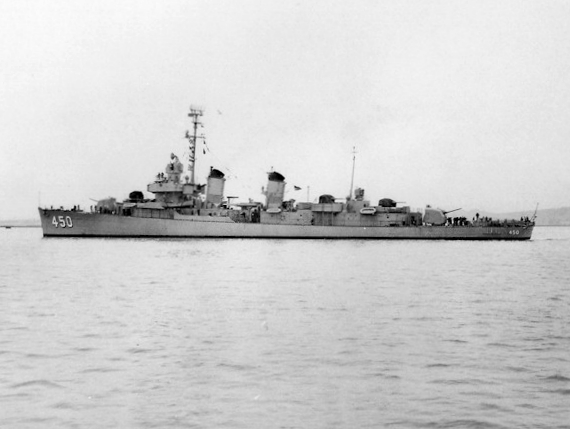
O’Bannon out of Mare Island after her DDE conversion in 1951
From 17 January 1949 O’Bannon was chosen for conversion as DDE, proceeding until 10 February 1950 at Long Beach Naval Shipyard (DDE-450, 26 March 1949). Fully recommissioned on 19 February 1951 and homeported to Pearl Harbor she started her post-reconstruction sea trials, training and weapons tests. When ready she sailed for her first tour of duty (TOD) with the United Nations forces in Korea on 19 November. She stayed in the area, as carrier screen for seven months and became flagship for the Wonsan Element of the East Coast Blockade and Escort Group, with shore bombardments. Next she returned to convoy escort between Korea and Japan.
Back to Pearl Harbor for maintenance and training in June 1952, she took part atomic tests off Eniwetok. By April 1953 she left for her second Korean TOD with the carriers. She also took part in the Taiwan Patrol and trained off Japan and Okinawa.
postwar, she trained with the 7th Fleet, alternating all six-month between the Far East and home waters of Pearl Harbor. She made also numerous port visits to the Philippines, Taiwan, Australia and New Zealand or Hong Kong. She was her for the commemoration of the Battle of the Coral Sea (she was still in constuction at the time) and trained woth SEATO allies or the Marines. When in Pearl Harbor, she helped training reservists and sailed to look for missile test cones or the Appollo missions when they started. By 1962, she took part in the atomic tests at Johnston Island.
O’Bannon’s Vietnam war
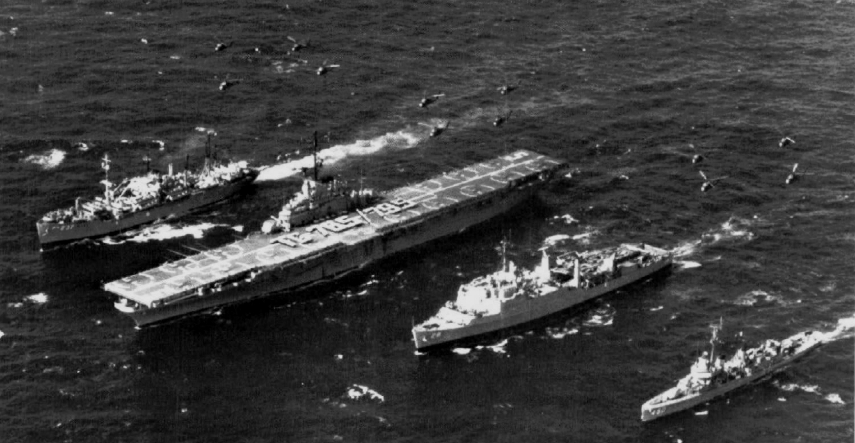
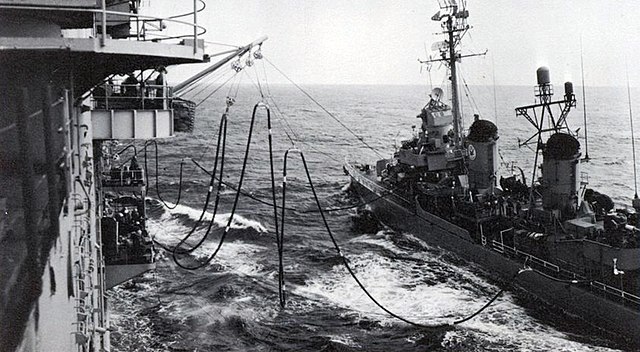
O’Bannon with TG 76-5 underway and refuelling from USS Valley Forge (LPh-8) in April 1965
In 1964, O’Bannon became the centerpiece of the 1965 film “In Harm’s Way”. starrubg Kirk Douglas. Her first TOD off the coast of Vietnam was her 1964–65 deployment. On 26 December, she left Hong Kong for hydrographic surveys. Her 1966 TOD was as plane guard for USS Kitty Hawk, striking objectives on South and North Vietnam. By May-June, O’Bannon took part in the gunline, destroying Vietcong base camps and troop concentrations among others.
She sailed to Yokosuka and from there to Pearl Harbor on 30 July. Next she took part in Apollo space craft recovery operations in August, used for Gemini 11 in September. She visited Guam in 1967 and was prepared for another Vietnam TOD, bound for Japan on 28 September, then Subic Bay on the 15th of October. She screen the new supercarrier USS Constellation as plane guard and patrolled atn Yankee Station until 4 November 1967. After rest at Subic Bay and Hong Kong, she took the gunline at Da Nang. She visited Taiwan in December but returned to cover fire on the DMZ. She rescued the crew of an American plane and silenced an enemy battery that targeted her in the process. She stayed on the gun line in 1968 as well.
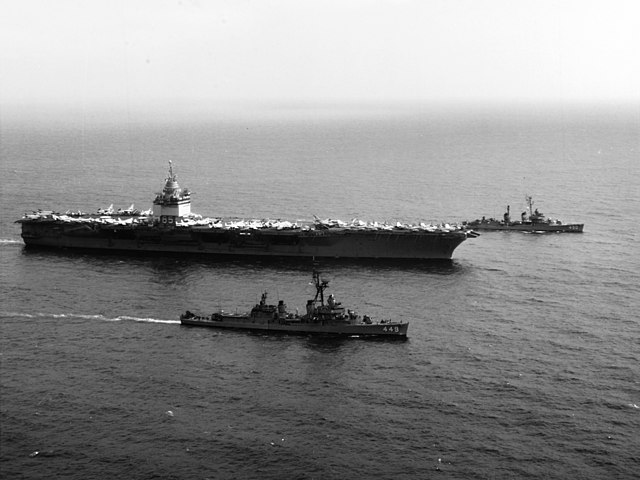
New generation: Old Vets USS O’Bannon and Nicolas escorting CVAN 65 USS Enterprise to the Gulf of Tonkin on 6 March 1968
It’s only on 30 January 1970, that O’Bannon was decommissioned in a unusual ceremony at Pearl Harbor due to her amazing career, with all the top brass present, and was stricken, sold for scrap on 6 June 1970, BU in 1972. In addition to her Presidential Unit Citation and 17 battle stars, three battle stars for Korea, she was nicknamed the “Lucky O” since she went trhough hell and back without casualty…
Her presidential Unit Citation was as followed:
For outstanding performance in combat against enemy Japanese forces in the South Pacific from October 7, 1942, to October 7, 1943. An aggressive veteran after a year of continuous and intensive operations in this area, the U.S.S. O’BANNON has taken a tremendous toll of vital Japanese warships, surface vessels and aircraft. Launching a close range attack on hostile combatant ships off Guadalcanal on the night of November 13, 1942, the O’BANNON scored three torpedo hits on a Japanese battleship, boldly engaged two other men o’ war with gunfire and retired safely in spite of damage sustained. During three days of incessant hostilities in July 1943, she gallantly stood down Kula Gulf to bombard enemy shore positions in coverage of our assault groups, later taking a valiant part in the rescue of survivors from the torpedoed U.S.S STRONG while under fierce coastal battery fire and aerial bombing attack and adding her fire power toward the destruction of a large Japanese naval force. In company with two destroyers, the O’BANNON boldly intercepted and repulsed nine hostile warships off Vella Lavella on October 7, 1943, destroying two enemy ships and damaging others. Although severely damaged, she stood by to take aboard and care for survivors of a friendly torpedoed destroyer and retired to base under her own power. The O’BANNON’s splendid acheivements and the gallant fighting spirit of her officers and men reflect great credit upon the United States Naval Service.
 Destroyer Squadron 23
Destroyer Squadron 23
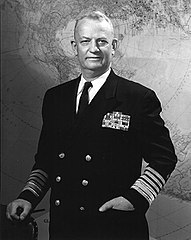 DESRON 23 nicknamed “the Little Beavers” was all composed of brand new Fletcher class DDs and probably the most famous and decorated destroyer unit of the USN. Commanded by Commodore Arleigh “31 knot” Burke it covered the initial landings at Bougainville (November 1943) and fought in 22 separate engagements in four months. They collectively destroyed a Japanese cruiser, nine destroyers, one submarine, many smaller vessels and c30 aircraft. USS Foote (DD-511), USS Charles Ausburne (DD-570), USS Spence (DD-512), USS Claxton (DD-571), USS Dyson (DD-572), USS Converse (DD-509) and USS Thatcher (DD-514) composed it. At the Battle of Cape St. George they intercepted 5 IJN destroyers sinking 3. At the Battle of Empress Augusta Bay they screen TF 39, attached to CruDiv 12 (Cleveland Class Cruisers, USS Montpelier, Cleveland, Columbia, Denver) sinking IJN Sendai and a destroyer. Thus unit was awarded the Presidential Unit Citation:
DESRON 23 nicknamed “the Little Beavers” was all composed of brand new Fletcher class DDs and probably the most famous and decorated destroyer unit of the USN. Commanded by Commodore Arleigh “31 knot” Burke it covered the initial landings at Bougainville (November 1943) and fought in 22 separate engagements in four months. They collectively destroyed a Japanese cruiser, nine destroyers, one submarine, many smaller vessels and c30 aircraft. USS Foote (DD-511), USS Charles Ausburne (DD-570), USS Spence (DD-512), USS Claxton (DD-571), USS Dyson (DD-572), USS Converse (DD-509) and USS Thatcher (DD-514) composed it. At the Battle of Cape St. George they intercepted 5 IJN destroyers sinking 3. At the Battle of Empress Augusta Bay they screen TF 39, attached to CruDiv 12 (Cleveland Class Cruisers, USS Montpelier, Cleveland, Columbia, Denver) sinking IJN Sendai and a destroyer. Thus unit was awarded the Presidential Unit Citation:
For extrordinary heroism in action against enemy Japanese forces during the Solomon Islands Campaign, from November 1, 1943, to February 23, 1944. Boldly penetrating submarine-infested waters during a period when Japanese naval and air power was at its height, Destroyer Squadron TWENTY THREE operated in daring defiance of repeated attacks by hostile air groups, closing the enemy’s strongly fortified shores to carry out sustained bombardments against Japanese coastal defenses and render effective cover and fire support for the major invasion operations in this area. Commanded by forceful leaders and manned by aggressive, fearless crews the ships of Squadron TWENTY THREE coordinated as a superb fighting team; they countered the enemy’s fierce aerial bombing attacks and destroyed or routed his planes; they intercepted his surface task forces, sank or damaged his warships by torpedo fire and prevented interference with our transports. The brilliant and heroic record achieved by Destroyer Squadron TWENTY THREE is a distinctive tribute to the valiant fighting spirit of the individual units in this indomitable combat group and of each skilled and courageous ship’s company.
Arleigh Burke became CNO under the Eisenhower administration, making an unprecendented 3 terms, and retired in 1961 under Kennedy, but still went to have a considerable influence on the USN during its most transformative years, he was for example an early supported of Hyman Rickover for the development of quality SSN and SSBNs. A tireless hard worker he inclfuenced a whole generation of officers. By 1991 he had the chance of being still alive when a new namesake destroyer class was inaugurated.
 USS Heerman, the hero of Samar (DD 532)
USS Heerman, the hero of Samar (DD 532)
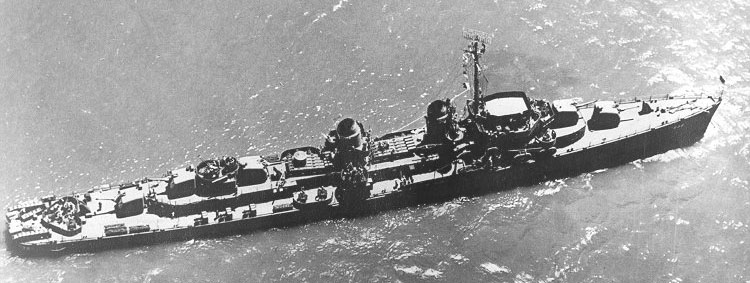
Heermann’s Pacific Campaign
USS Heermann is one the shining stars of the Fletcher class, contributing to the immense fame the class gained in WW2. Taking part in the “last stand of the Tin Can Sailors” in which she and other DD heroes of Task Unit 77.4.3 (“Taffy 3”) repelled the IJN at the Battle off Samar in October 1944, against overwhelming odds. Heermann was the one in fact of “Taffy 3” to survived, although badly mauled. In 1961 she had a new career with the Argentinian Navy until 1978. An exceptional vessel, well decorated.
She was named after Lewis Heermann, born on 3 August 1779 in Kassel, Surgeon’s Mate in the USN by 8 February 1802 and distinguished in the Barbary War with Cdr. Stephen Decatur at Tripoli. Heermann later milited for better medical care for the Navy, and convinced the Congress to authorize hospitals at several naval stations. He would serve in the Mediterranean Sqn. until May 1833.
USS Heermann was launched on 5 December 1942 at Bethlehem Shipbuilding Co. San Francisco, commissioned on 6 July 1943.
After shakedown training off California she was assigned to the 5th Fleet on 21 October 1943, taking part in Operation Galvanic, the assault on the Gilbert Islands, joining RADM Harry W. Hill’s Southern Attack Force, on 20 November. In the lagoon she sank small vessels, and targeted shore objectives for troops advancing inland. Returning to Pearl Harbor for maintenance and training she departed on 23 January escorting an attack transport reserve force. She took part in the assault on Kwajalein and escorted carriers, stopped at Eniwetok Atoll and shelled Parry Island.
Back to the 3rd Fleet, TF 39 on 18 March 1944 after stopping at Majuro Lagoon and Florida Island in the Solomons she escorted convoys to Emirau Island, destroying barges off New Hanover. Back to Purvis Bay on 3 June she shelled Fangelawa Bay in New Ireland on 11 June followed by ASW patrols to the Admiralty, Caroline, and Marshalls and by mid-1944, zscorted merchant shipping to the New Hebrides and Nouméa. On 6 September 1944 she departed with RADM W. Sample’s escort carrier force for the invasion of the Palau Islands. Next she took part in the Philippine Islands and notably her entire career’s shining moment: The Battle off Samar.
USS Heermann screened transports and landing ships to Leyte under Commander Amos T. Hathaway, with RADM Thomas L. Sprague’s Escort Carrier Group (Task Group 77.4) at the head of Three Taffies based on their voice calls. She was joined with USS Hoel and Johnston at RADM Clifton Sprague’s Taffy 3 which he commander from flagship USS Fanshaw Bay, at the head of five other escort carriers. On 25 October 1944 this force was at the east of Samar steaming north, so called the “Northern Air Support Group”. At 06:45 lookouts detected AA fire from Admiral Takeo Kurita’s “Center Force” approaching. Escorts started to make smoke screens and USS Heermann steamed into action through the escort carriers (she was at the rear at the time), and after launching their planes, formed a rough circle in Leyte Gulf, laying smoke and using rain squalls to hide. The destroyers ran at full speed perhaps 100 yards (91 m) apart, narrowly avoiding collisions, notably USS Heermann with Samuel B. Roberts and Hoel.
Torpedo runs started with 5-inch guns fires, Heerman concentrating on IJN Chikuma, while launching her torpedoes at Haguro. Veering to avoid volleys from four battleships she turned her fire on IJN Kongō at the head of the pack, and launched launched three torpedoes at her. Then she swapped to Haruna, fired three more torpedoes from 4,400 yards (4,000 m). She then retreated after expecting at least a hit. But they were all evaded, albeit these moves broke their pursuit. Kutota’s flagship, IJN Yamato caught between two spreads also had to make hard turns and this distracted her for the pursuit.
After laying another smoke screen starboard of the carriers, USS Heermann charged again, this time at the four cruisers. She started firing at Chikuma but soon had at least two 8-inch (203 mm) hits on her forward section. Flooded, she started to plough so far that her anchors started to drag her further and had her forward 5-inch destroyed. She was saved however by the vigorous action of Helldivers and Wildcats from the escort carriers. Chikuma was even forced to withdraw, and while replaced by Tone, engaged Heermann until she withdrew. Returning to the carriers she layed another smoke screen, and saw the arrival of “Taffy 2″aircraft. They plunged and harass IJN Tone, forcing her to withdraw. Heermann’s Commanding Officer, Commander Amos Hathaway, was later awarded the Navy Cross.
Heermann was repaired at Kossol Passage and Mare Island, also having her main overhaul completed on 15 January 1945. Back to the fast carrier force, she was engaged in the Battle of Iwo Jima, and stationed for picket duty. She took part in a night bombardment of Minami Daito Jima and during the “siege”, repelled many kamikaze attacks and air raids. On 18 April with USS Mertz, McCord, Collett, and Uhlmann, plus cover from USS Bataan air group, her ASW patrols ended with the discovery and sinking of I-56 carrying kaitens. Her career went on as well off Okinawa until she was replenished in Leyte Gulf by late June. She was there for the last air strikes until 15 August 1945. That day she was in a dangerous radar picket station just 200 miles (320 km) southeast of Tokyo.
Despite the end of the war has been announced, a rogue kamikaze emerged from a cloud, but before she could closed in, she was short down by gunners, probably one of the very last actions of the war. She went on later screening the fast carrier task force and entered Tokyo Bay on 16 September 1945, patrolled until 7 October and sailed back home, decommissioned at San Diego, 12 June 1946.
Heermann’s Atlantic cold war career
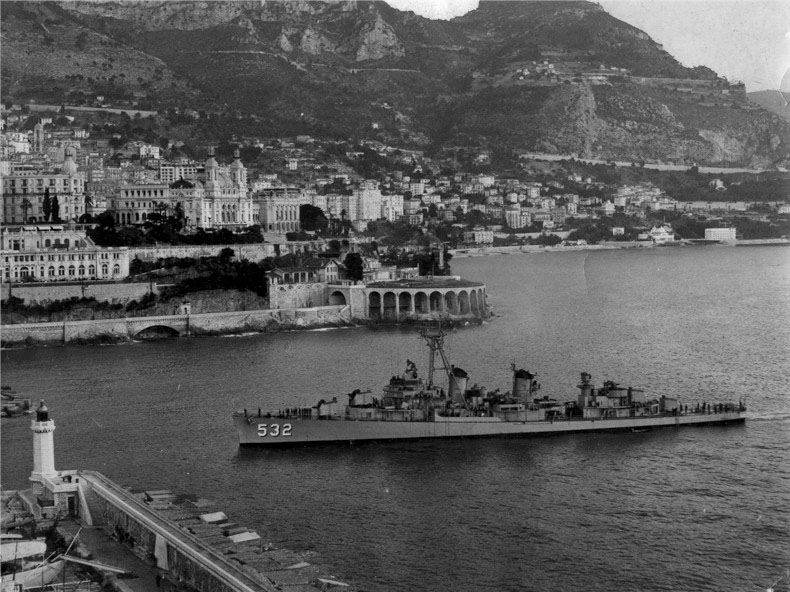
USS Heermann in Monaco, April 1956.
USS Heermann left the reserve for a re-commission on 12 September 1951, no conversion apparently, and after local training she sailed on 4 January 1952 to NS Newport, Rhode Island, on 23 January. She trained off New England and the Virginia Capes in 1952, fleet problem in the Caribbean and back to the Northeastern seaboard. She made her first Atlantic crossing, to Plymouth in the summer of 1953 and back home more ASW exercizes. She started a world cruise on 3 December 1953, stopping at Yokosuka, after crossing the Panama Canal and stopping to San Diego and Hawaii, then Okinawa, escorting the 3d Marine Division landings exercise. She went to Korea, Iwo Jima, Japan and departed Yokosuka on 22 May 1954 to complete her cruise, via Hong Kong, Singapore, the Suez Canal, Port Said, Naples, Villefranche, Barcelona and Newport on 17 July 1954.
After more training along the Atlantic coast she joined the 6th Fleet off Lebanon, Israel, and Egypt. In April 1956 she was invited by Prince Rainier of Monaco for his Royal wedding with American actress (Miss) Grace Kelly visiting her on 19–24th, the crew providing for the wedding a 40-man honor guard. From Monaco, she joined the 6th Fleet off Greece and went home, Fall River on 28 May 1956. She would return to the Mediterranean to train with the Marina Militare.
She revisited Monaco at the invitation of Prince Rainier and Princess Grace and was back to Fall River on 20 February 1957. A gunnery schoolship at Newport until 30 June, she was assigned to the screen with USS Charles J. Badger of the carrier USS carrier Leyte, at the Naval Academy midshipmen. She was decommissioned at Boston, on 20 December 1957, Atlantic Reserve Fleet.
For her ww2 service, in addition to a presendential citation and 9 battle stars, she earned the Philippine Presidential Unit Citation.
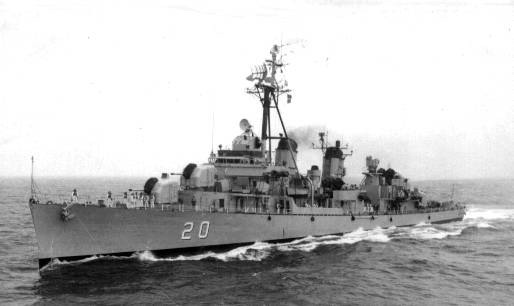
As ARA Almirante Brown
On 10 August 1961, an agreement was concluded and the destroyer was obtained by Argentina, reccommissioned, formally transferred four days later on loan basis under MDAP. She was renamed ARA (almirante) Brown (D-20), assigned to the Second Destroyer Division, stationed at Puerto Belgrano Naval Base. She actively participated in different exercizes by the Argentine Navy, and all UNITAS exercises with other navies in the region. Her last sortie took place on November 18, 1975, entering Puerto Belgrano to be removed from the 2nd DesDiv by March 15, 1976, associated to the General Directorate of Naval Material. She was sold to the Santa Rosa Metallurgical Establishments for scrapp, delivered on December 18, 1979. Se the figure of 1982 for her decommission is incorrect.
 USS Kidd (DD 661), pirate of the Pacific
USS Kidd (DD 661), pirate of the Pacific
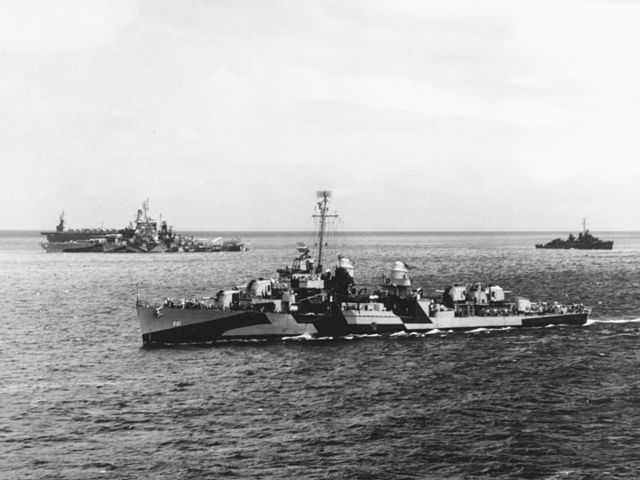
Kidd’s Pacific Campaign
USS Kidd was the first USN ship named after Rear Admiral Isaac C. Kidd, killed at Pearl Harbor while at the bridge of flagship USS Arizona, first US flag officer which died in this war, first American admiral killed in action. Her namesake destroyer was launched on 28 February 1943 at Federal Shipbuilding & Drydock Co. Kearny NJ as a “square/low bridge” type. commissioned on 23 April 1943. She sailed out of Brooklyn Naval Shipyards to NYC Harbor flying the Jolly Roger since at outfitting, her crew adopted the pirate captain William Kidd as mascot and a pirate figure was painted on her forward smokestack.
After shakedown off Casco Bay she sailed along New England and the Caribbean escorting capital ships from yards to the Pacific in August 1943, notably USS Alabama and South Dakota. She was in Pearl Harbor on 17 September 1943 and by 29 September ecorted new carriers to Wake Island for the 6 October raids and back on 11 October 1943.
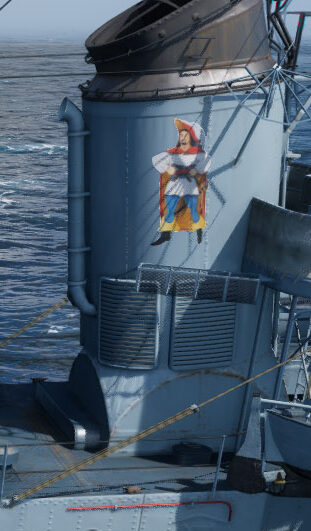 By Mid-October USS Kidd joined the strike force on Rabaul and later supported the Bougainville landings. While south of Rabaul on 11 November, she was asked to rescue crews from USS Essex air group’s aircraft spashing astern of the formation when attacked by IJN aviation. She shot down three, dodging torpedoes and bombs and performed the rescue. Cmdr. Roby received the Silver Star for it. The destroyer was back at Espiritu Santo on 13 November.
By Mid-October USS Kidd joined the strike force on Rabaul and later supported the Bougainville landings. While south of Rabaul on 11 November, she was asked to rescue crews from USS Essex air group’s aircraft spashing astern of the formation when attacked by IJN aviation. She shot down three, dodging torpedoes and bombs and performed the rescue. Cmdr. Roby received the Silver Star for it. The destroyer was back at Espiritu Santo on 13 November.
Next she screened carriers to Tarawa (Gilbert Islands campaign) in November 1944. On the 24th she spotted 15 low-flying (below radar) bombers and claimed two Aichi D3A “Val”. After patrols and other missions in the Gilbert Islands she was back to Pearl Harbor on 9 December.
On 11 January 1944 she was at Espiritu Santo, and sailed for Funafuti (19 January)for the Marshall Islands campaign in January-February 1945. She also shelled Roi and Wotje and ended in Kwajalein. From 20 March to 14 April she guarded an airstrip under construction on Emirau. She covered the landings at Aitape and Hollandia on 16 April-7 May. Next she took part in the Marianas campaign until 8 July, shelled Guam 8 July-10 August. She was back to Pearl Harbor on 26 August 1944 for a short overhaul, and returned on 15 September to Eniwetok, Manus, joining the Philippines invasion fleet entering Leyte Gulf on 20 October. She covered the landings bu was detached on 14 November to Humboldt Bay in New Guinea. By December she sailed for home and a major overhaul at Mare Island Navy Yard.
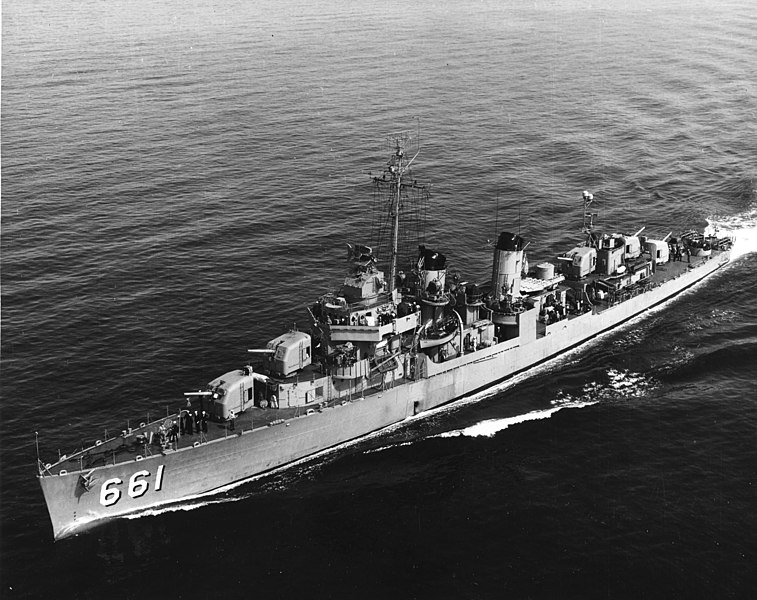
USS Kidd in 1951. She was not modernized.
When completed she departed and by 19 February 1945 joined TF 58 for the invasion of Okinawa. For these first days she was everywhere between guarding the fleet, and shelling positions along the shore, SAR missions, search and destroy missions on mines, suicide boats, early warning (radar picket) and supported the badly damaged USS Franklin, as claiming many kamikazes.
On picket station 11 April 1945 with USS Black, Bullard, and Chauncey she repelled three air raids but in the afternoon one Kamikaze went through and crashed on USS Kidd (38 KiA, 55 wounded). But damage control being done she went on with her duties with the task group, while driving off more attacks. Repaired at Ulithi on 2 May she headed for Hunter’s Point Naval Shipyard on 25 May 1945 for repairs and overhaul. On 1 August 1945 she was back to Pearl Harbor but as the war ended, she returned directly to San Diego for inactivation. She was decommissioned on 10 December 1946, Pacific Reserve Fleet.
USS Kidd in the cold War
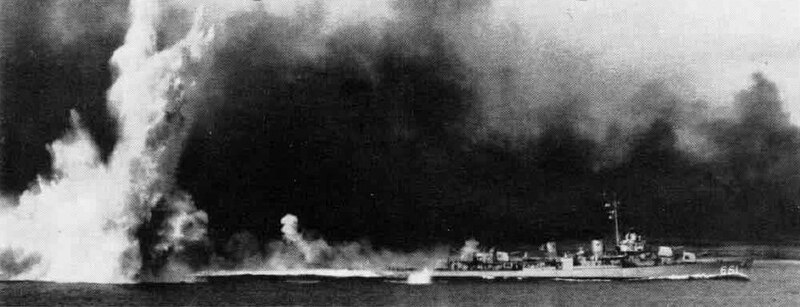
Dropping depht charges in an exercize in 1958
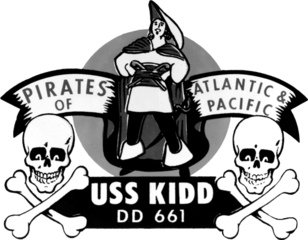 In the reserve fleet she was recalled when North Korea invaded. Recommissioned on 28 March 1951 wothout conversion but simple modernization, she was sent to the Western Pacific on 18 June, Yokosuka on 15 July, and Task Force 77 in the Korean coast. On 21 September she sailed on the Korean East Coast and from 21 October to 22 January 1952 shelled shore targets from Wan-Do Island to Koesong. She later joined DesDiv 152 to San Diego on 6 February 1952 and was back for a second TOD in Korea on 8 September 1952, part of a hunter-killer group off Kojo and the gunline off North Korea. During peace negociations she patrolled along the Korean coast until 3 March 1953. She headed for Midway and Pearl Harbor, then San Diego and an overhaul on 20 March. Ported to Long Beach on 20 April 1953 she was rammed by the Swedish freighter Hainan, with repairs going on until 11 May 1953.
In the reserve fleet she was recalled when North Korea invaded. Recommissioned on 28 March 1951 wothout conversion but simple modernization, she was sent to the Western Pacific on 18 June, Yokosuka on 15 July, and Task Force 77 in the Korean coast. On 21 September she sailed on the Korean East Coast and from 21 October to 22 January 1952 shelled shore targets from Wan-Do Island to Koesong. She later joined DesDiv 152 to San Diego on 6 February 1952 and was back for a second TOD in Korea on 8 September 1952, part of a hunter-killer group off Kojo and the gunline off North Korea. During peace negociations she patrolled along the Korean coast until 3 March 1953. She headed for Midway and Pearl Harbor, then San Diego and an overhaul on 20 March. Ported to Long Beach on 20 April 1953 she was rammed by the Swedish freighter Hainan, with repairs going on until 11 May 1953.
Until late 1959 USS Kidd alternated WestPac West Coast search for soviet subs. She also made several port svisits in Japan, Okinawa, Hong Kong, Philippines, Sydney, and in the Taiwan Strait.
On 5 January 1960 she crossed the Panama Canal to Philadelphia, and started a serie of Naval Reserve training cruises. The Berlin Crisis in 1961 had her in the fleet for extended exercises. By December 1961 she provided gunboat diplomacy off the Dominican Republic. At Norfolk on 5 February 1962 she was prepared to join Task Force Alfa for a large ASW exercises. On 24 April she was posted to the Naval Destroyer School at Newport and cruised the Carribean by July 1962. Kidd was evenrually decommissioned on 19 June 1964, Atlantic Reserve Fleet in Philadelphia.

At the time, many vets asked the Navy to preserve at least three Fletcher destroyers as memorials: After a wide review, USS The Sullivans, Cassin Young and Kidd were chosen. Louisiana congressman William Henson Moore selected Kidd for his circumscription, and she towed from Philadelphia to Baton Rouge on 23 May 1982, now part of the Louisiana Naval War Memorial Commission. An open air museum vessel she os the best preserved WW2 “in her juice” pacific campaign destroyer, fully restored to her August 1945 configuration on 3 July 1997. She has a special mooring in the Mississippi with floats lifting her as the river rises and sitting otherwise on keel blocks down to the keel. From 1986 Kidd she is a National Historic Landmark for the whole Fletcher class.
 USS The Sullivans (DD): For five brothers
USS The Sullivans (DD): For five brothers
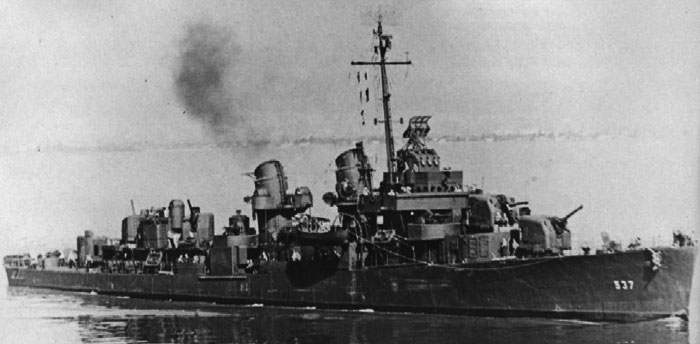
USS The Sullivans (DD-537) was named after the five Sullivan brothers (George, Francis, Joseph, Madison, and Albert) lost on USS Juneau at the Battle of Guadalcanal on 13 November 1942. She was indeed laid down as USS Putnam on 10 October 1942 in Bethlehem Shipbuilding Corp. and renamed Sullivan, then “The Sullivans” by President Franklin Roosevelt on 6 February 1943. She was launched on 4 April 1943, commissioned on 30 September 1943. After her shakedown cruise, she sailed with USS Dortch and Gatling on 23 December 1943 to Pearl Harbor and after extra training, was assigned to DesRon 52. On 16 January 1944 she joined TG 58.2 to the Marshall Islands. Her group was joined at Kwajalein by BatDiv 9. She arrived on 24 January at tke point to launch air strikes against Roi. She screened USS Essex, Intrepid, and Cabot and patrolled N/NW of Roi and Namur during the Battle of Kwajalein until 4 February and retired to Majuro.
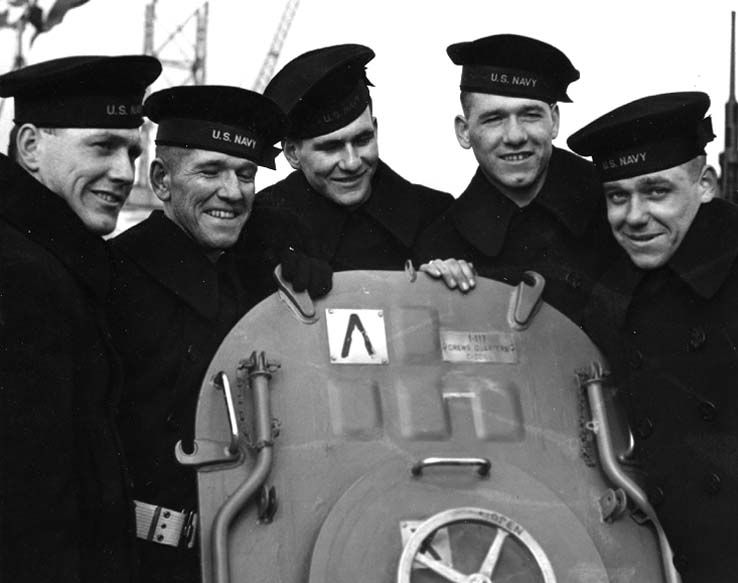
The Sullivans Brothers.
On the 12th she screened Task Group 58.2 (TF 58) for the raid on Truk, Roi and Namur. Later Intrepid was hit on the 17th and she was escorted to safety by Sullivans, Owen, and Stembel to Majuro. Next the destroyed sailed to Hawaii for upkeep. Back on the frontline she joined 58.2, 58.9, and 50.15 from Majuro to the Palaus: Yap, and Woleai. She drove off an air raid, then another the following day. After another run to Majuro she screened TG 58.2 raiding Hollandia, Tanahmerah, Wakde, and Aitape (New Guinea). Later in April she took part in air strikes on Truk. The Sullivans repelled another air attack, claiming two, one more crashing in flames close to her port beam.
On the NW coast of Ponape on 1 May she covered the Battleships bombarding the island. She shelled Tumu Point and landing barges.
After refuelling from Yorktown she was back at Majuro on 4 May and on the 14th was again screening TG 58.2 for Marcus and Wake. Whle back to Majuro, she took part in the sub hunt.
On 6 June she headed for Saipan, Tinian, and Guam for more air strikes, and shot down one attacker.
On the 13th she saved 31 Japanese merchant seamen, transferred to Indianapolis.
On 19 June 1944 she took part in the Battle of the Philippine Sea, and spotted Yokosuka D4Y “Judy” in approach from 23,000 feet (7,000 m), splashing one. Next she screened the attack on Pagan Island, and new Saipan-Tinian-Guam strikes before retiring to Eniwetok.
On 30 June she accompanied the carriers again striking Saipan and Tinian and she served as fighter direction ship for TU 58.2.4.
On the 4th of July she joined TU 58.2.4, shelling airfields, shore batteries and other objectives along the west coast of Iwo Jima. She notably put in flames a serie of G4M “Bettys” and later caught and destroyed a Daihatsu. Until 22 July she operated in the Marianas between Guam and Rota and now the supply point ported to Saipan. Sje took part on the Palaus raid on 26th and 27th and joined TG 58.4 on 30 July until 6 August, then TG 58.7 and TP 34 until 11 August, then back to Eniwetok.
September saw her starting the screening of carrier strikes over the Philippines. On the 7th she was on radar picket duty for TG 38.2 until the 10th. While back at Tanapag Harbor in Saipan for upkeer, on the 28th she went alongside USS Massachusetts for respelishing and upkeep. However but cross-swells caused a collision, her hull and superstructure being damaged. She had repairs at the tender Dixie when caught by a heavy storm wrecking the anchorage. She drifted free downwind and collided with Uhlmann. She had later an overhaul at Ulithi.
On 6 October 1944, she accompanied the carriers to Formosa and the Ryukyus and repelled an air assault on the 12th, in fact several waves for six hours. She downed a “Betty” and shared three more planes, then five planes, manoeuvering to dodge bombs and torpedoes at 18-29 knots trying to avois collisions all along.
The air attack resumed at 21:05 on the 12th until 02:35 on the 13th, and the Japanese used to jam American radars. On the 13th was launched a raid on Formosa. She helped the crippled Canberra. On the 14th she dhot down at least one “Betty” attacking Houston. She escorted the damaged cruiser (nicknamed “CripDiv 1) to Ulithi.
On the 16th she try to repel another attack in which Houston was badly hit. The Sullivans downed a Yokosuka P1Y “Frances” and shot down another splashing close to the bow of Santa Fe.
She rescued 118 from Houston and later transferred them to USS Boston. When back to Ulithi an IJN surface force closed in, before being mauled by TF 38′ air groups. Comdr. Ralph J. Baum received a first Silver Star after these actions.
On 20 October, The Sullivans joined TG 38.2 attacking the central Philippines during the Leyte landings. On the 24th, a fleet was located off Mindoro, targeted by air strikes all day but air attacks by the Japanese went on and Sullivans downed her first army Nakajima Ki-43 “Oscar”.
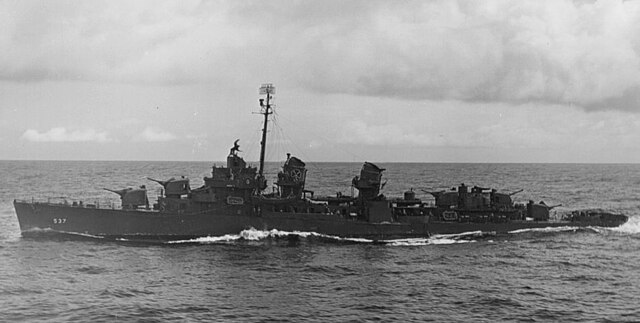
By 25 October she sailed with TF 34 north of TF 38 and on the 25th dawn air strikes 60 miles (97 km) saw a reformation at 11:00 when TF 34 reversed course and after refuelling DDs reformed the fast striking group TG 34.5 (Iowa, New Jersey, three light cruisers, 8 destroyers) sweeping south close to Samar and trying to finish of Kurita’s formation crippled by Taffy 3. The Sullivans rejoined TG 38.2. without spotting any ship. Routune operations went on until mid-November. On the 19th she downed a “Betty” and six days later another before reaching back Ulithi.
After training exercises in December she was back woth TG 38.2, screening air strikes on Manila and southern Luzon. On the 17th after commencing the weather deteriorated into Typhoon Cobra, all night and on the morning of 18 December. The Sullivans make true her “lucky shamrock” painted on her funnel, she emerged unscaved and looked for survivors for days. Qhe was back to Ulithi on Christmas.
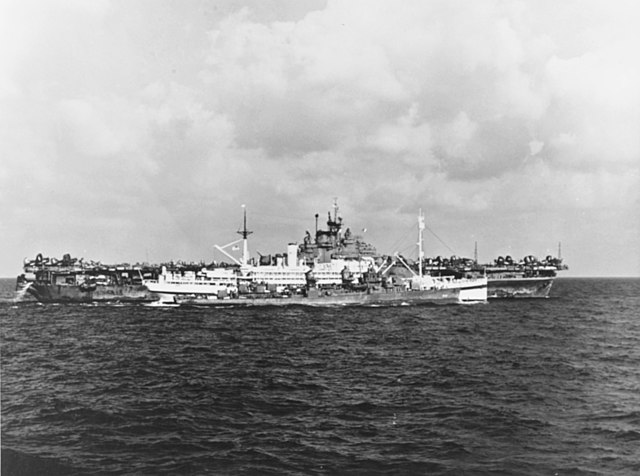
USS The Sullivans on 12 May 1945 with USS Bunker Hill, badly damaged, repaired by AH-9 USS Bountiful
She made a short run to Manus escorting USS Iowa and returned to Ulithi to depart with TG 38.2’s for air strikes on Formosa postponed by heavy weather in early January 1945. TG 38.2 also made strikes against Saigon and Camranh Bay. Later she joined the bombardment group TG 34.5, looking for Japanese merchantmen with little success. Next were striked against Hainan Island, Hong Kong, and Formosa, with the destroyer on radar picket duty 10 miles (16 km) ahead.
After resplenishment in Ulithi she returned with TG 58.2 starting striked on Honshu and Tokyo on 16-17 February. Until the 21st she assisted the landings on Iwo Jima. Next she followed TF 58 to Okinawa on 28 February. She spotted and destroyed a drifting mine. She folloed the fleet to Ulithi after the first strikes.
12 days she was back to Kyushu, southern Honshū for the invasion of Okinawa screening TG 58.2. On 20 March she witnessed the fiercest kamikaze attack so far.
The Sullivans assited the crippled USS Halsey Powell and splashed a kamikaze and later a Mitsubishi A6M “Zeke”.
Later she retired toward Ulithi but was attacked on 21 March, spotting a twin-engined “Frances”, splashed at 3,000 yards (2,700 m) abeam. She also directed CAP Hellcats from Intrepid, to a “Nick” or “Dinah”; On 25 March she was at Ulithi for upkeep and later joined TF 58 off Okinawa, between plane guard and radar picket duty. Air attacks multipled, she shot down several. On 29 April, she was fuelling from Bunker Hill when a kamikaze alert forced her out, witnessing USS Hazelwood and Haggard being striked. She also evacuated casualties from Bunker Hill on 12 May.
Later she assisted USS Enterprise also hit by a kamikaze and she short fown four that day. This was to be her last combat action in this war.
After some upkeed at San Pedro Bay, Leyte Gulf on 1 June she departed on the 20th for Pearl Harbor and the west coast, overhauled at Mare Island on 9 July. Her crew was on leave on V-Day.
She was prepared for reserve, decommissioned at San Diego on 10 January 1946, Pacific Reserve Fleet.
Korean War
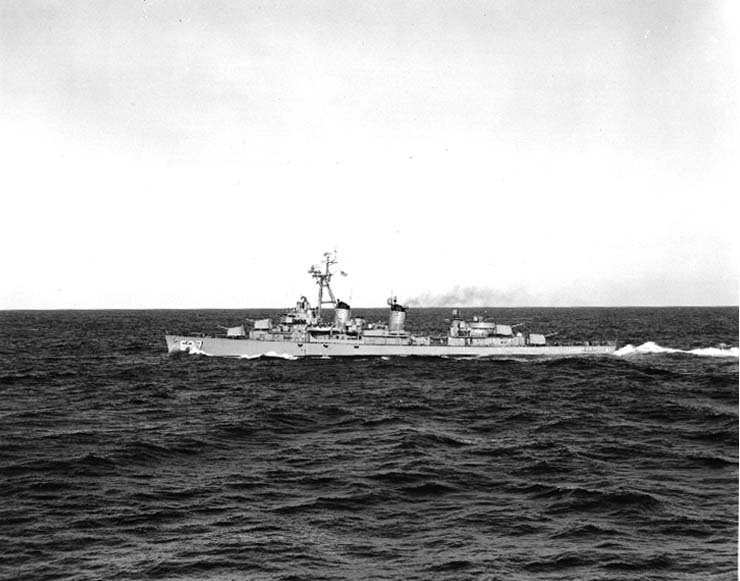
The Sullivans was reactivated from May 1951, recommissioned on 6 July 1951 with much changes. Based in Newport, via the Panama Canal she trained in the winter of 1951–52 and departed on 6 September 1952 for Japan via Panama, San Diego, Pearl Harbor, Midway to Sasebo on 10 October 1952. She started training and combat operations with TF 77 off the eastern Korea. She multiplied missions until 20 October 1952 and had a short refit at Yokosuka.
She stopped en route to Okinawa and was back on 16 November 1952 to resume her patrols, screening and plane guard duty now striking North Korea and closing up to 75 miles (120 km) of Vladivostok when flew off by MiG-15 fighters, kept at bay by Grumman F9F Panthers, which downed two. She had another refit at Sasebo, by December 1952 and was later tasked of blockading the Korean coasts notably at Area “G” On the 16th off Songjin she shelled an important rail terminus and supply center and later a railroad bridge, while shelled by shore batteries. None hit but she was showered by shell fragments and silenced them.
She made another refit at Yokosuka in 26 January and later started her way home via Okinawa, Hong Kong, Subic Bay, Singapore, Colombo, Bombay, Bahrain and Aden, the Red Sea, Suez Canal, stopped in Cannes, France via Naples and refuelled at Gibraltar before Newport on 11 April 1953.
With the 6th Fleet

She was deployed to the Mediterranean by late 1953 for her first 6th Fleet TOD until 3 February 1954 aletrnated with east coast-Caribbean training until May 1955. She made a second TOD from May to August. This alternating routine went on between the east coast and Mediterranean. In 1958 the communist threat on Lebanon prompted Eisenhower to send the fleet and land troops to protect Americans citizens. Sullivans supported Marines at Beirut. Later back home she had a 3 month overhaul, and training at NAS Guantanamo Bay.
From March 1959 she joined the hunter/killer USS Lake Champlain, followed by a midshipman cruise and another Mediterranean TOD. By the spring of 1960 she was present at ASROC evaluations off Key West and later she rescueed survivors from a U.S. Air Force KC-97 Stratofreighter off Cape Canaveral.
After NATO exercises she started her winter seaons stopping at Lisbon, and heading to the Suez Canal, Red Sea, and Karachi. In October-November she took part in “Midlink III” joint operations. Later in the Med she took part in exercises with the French Navy and 6th Fleet.
January 1961 guarded the SSBN Abraham Lincoln in sea trials off Portsmouth. Later she took part in Operation Springboard. She visited Martinique and in the West Indies support marine landing exercises at Vieques. She was later trained to recuperate capsuls from Project Mercury, with Lake Champlain at NAS Mayport, and later assisted Freedom 7. She made a midshipman cruise in June and until February 1962, she was in overhaul at Bostond. She became school ship, model destroyer for officer students to understand destroyer operation, making two training cruises to the Caribbean. October 1962 saw her in the Cuban missile crisis, as part of the blockade until resolution.
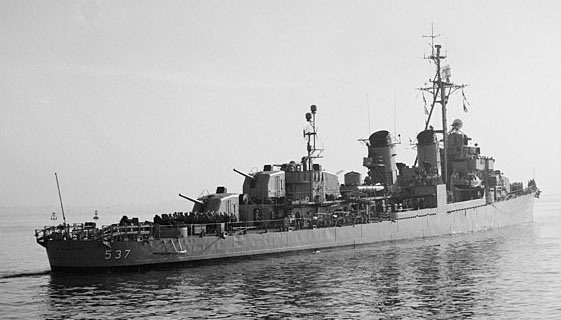
On 7 January 1963 she resumed training cruises, and local operations for the Destroyer School, the a search after the loss of USS Thresher off Boston, 10 April 1963. Until 1964 she continued training officer students. On 1 April 1964 she was sent to the Naval Reserve Force, HP New York City. She continued cruises with reserves, visiting Halifax and Saint John as well as Charlottetown, and Prince Edward Island or down to Palm Beach.
With 9 battle stars + 2 in Korea to her credit, she was decommissioned on 7 January 1965 at Philadelphia, in reserve until 1977, when processed for donation to the Buffalo and Erie County Naval & Military Park in Buffalo (New York), converted to a memorial.
She became a National Historic Landmark in 1986. She had repairs by 2022 and reopened in August, then was refusbished by the summer of 2023 to be winterized.
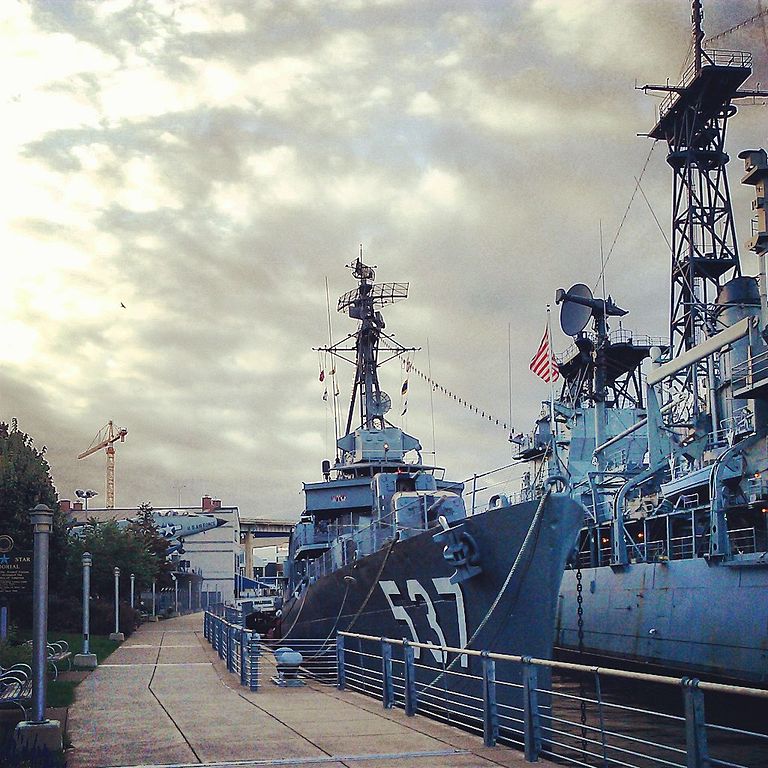




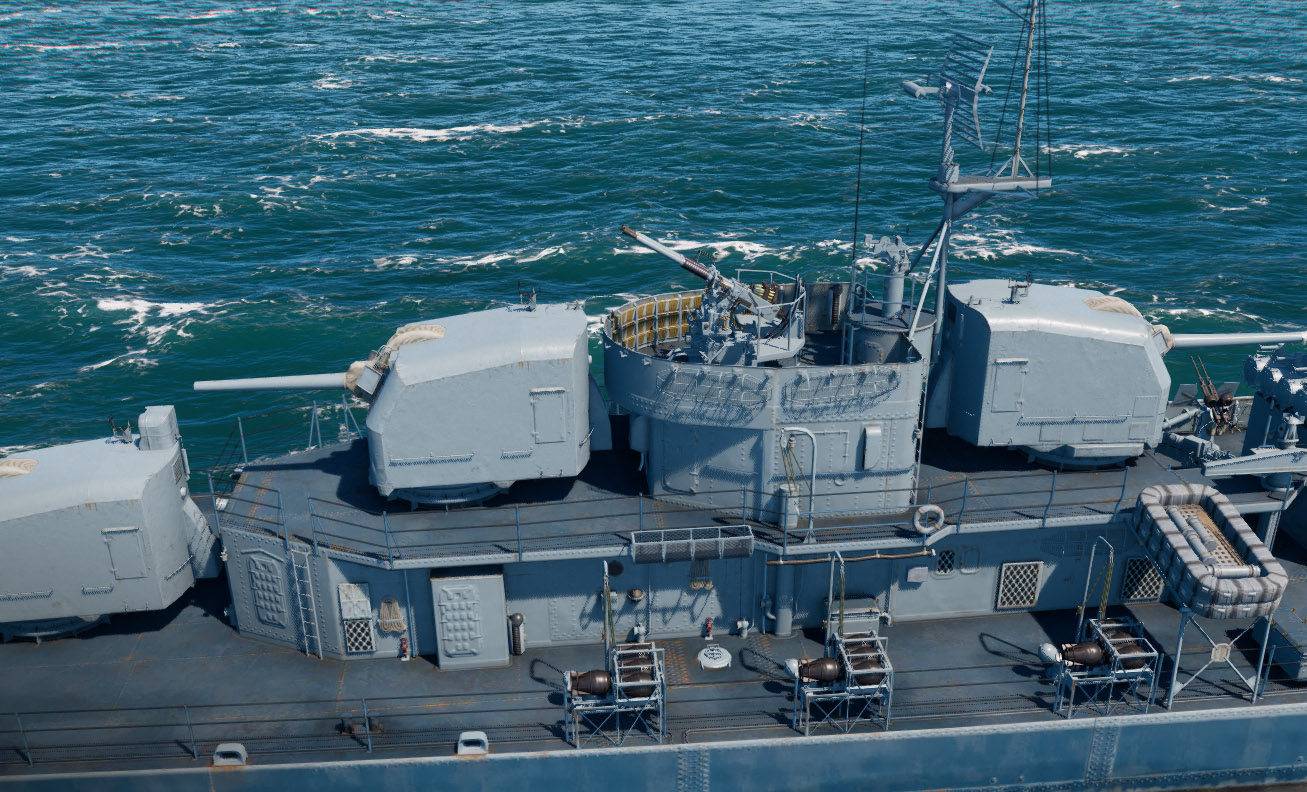
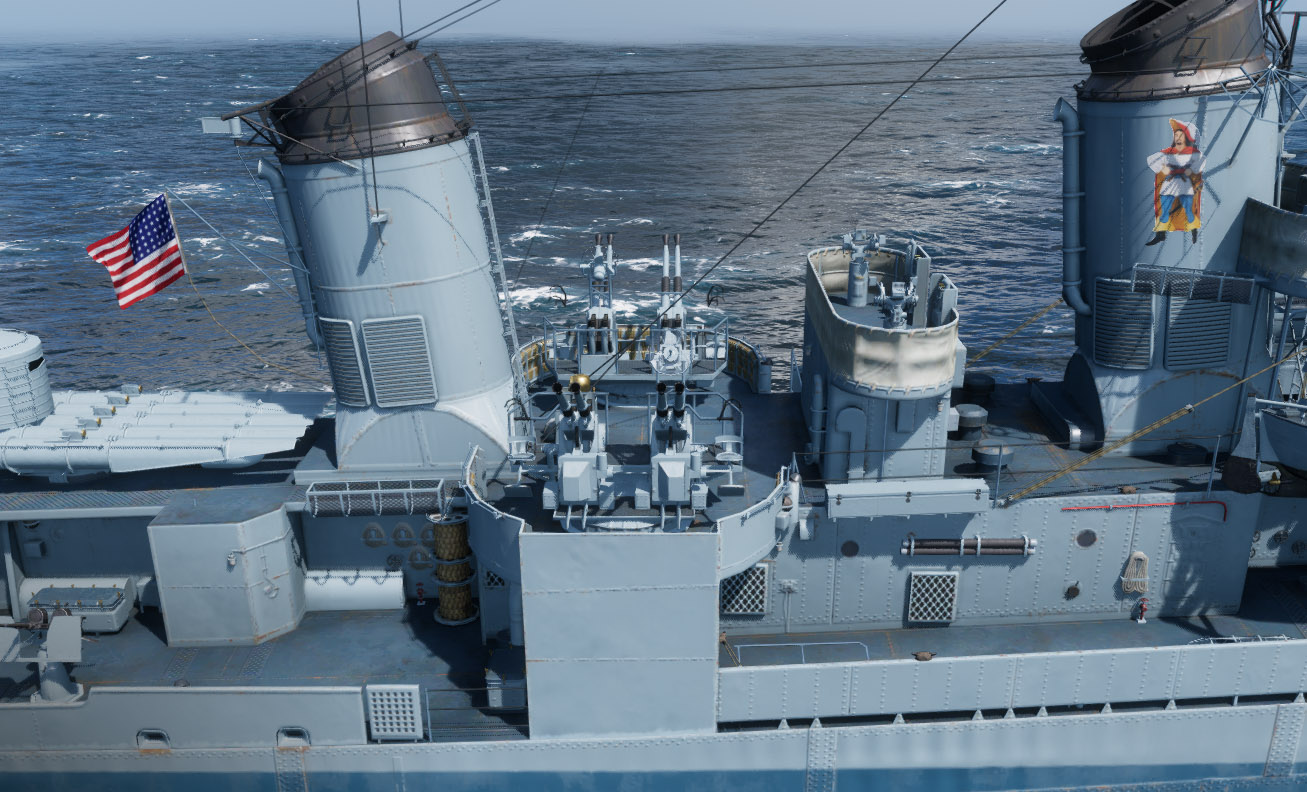
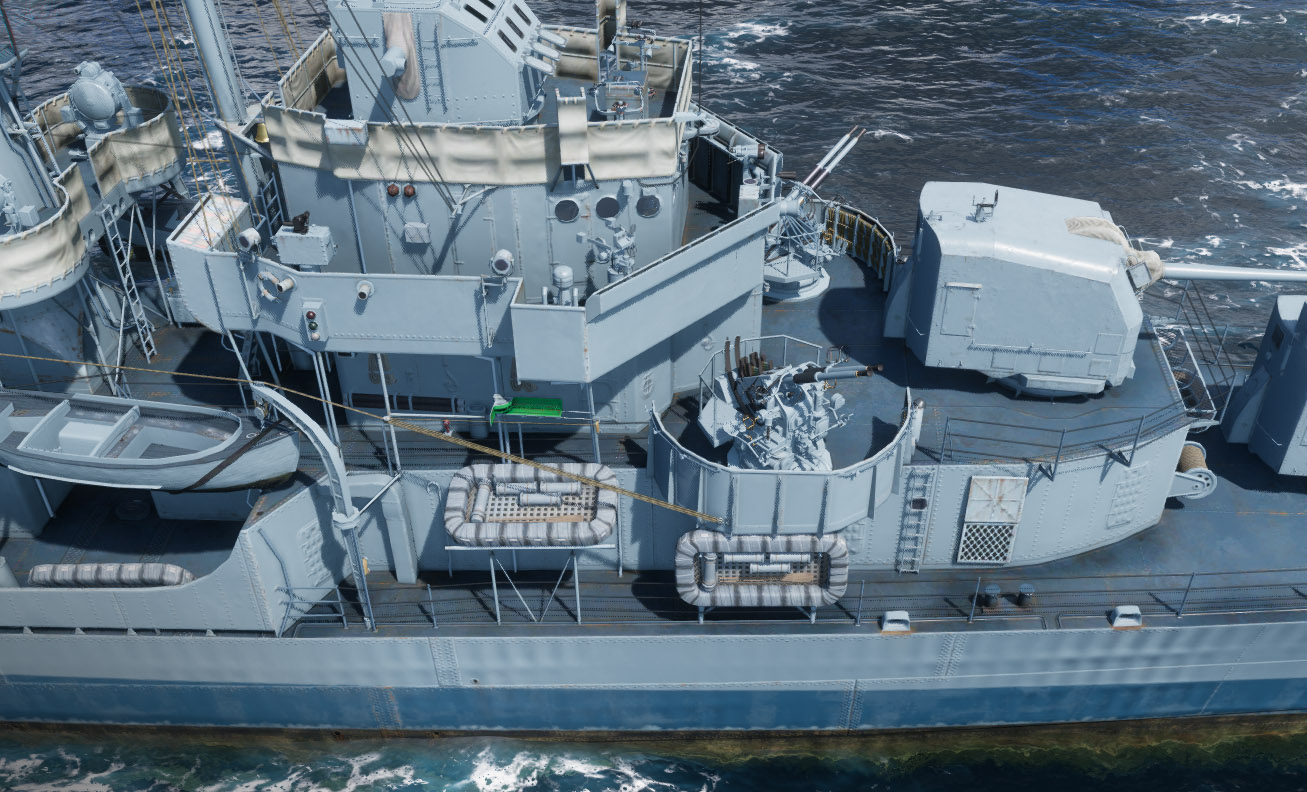

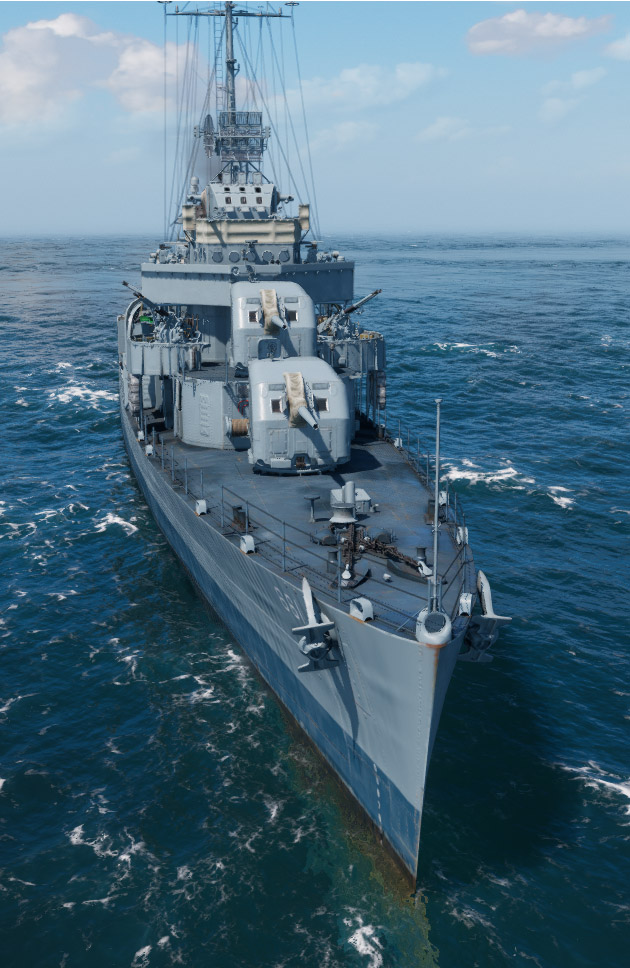
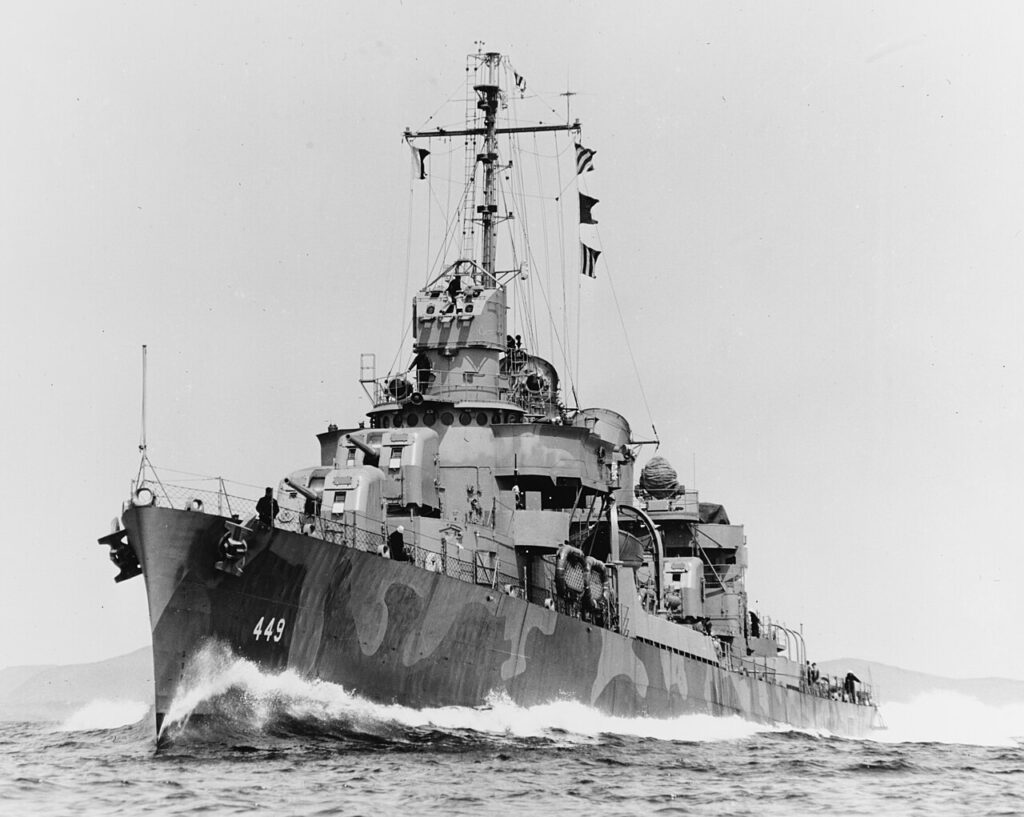
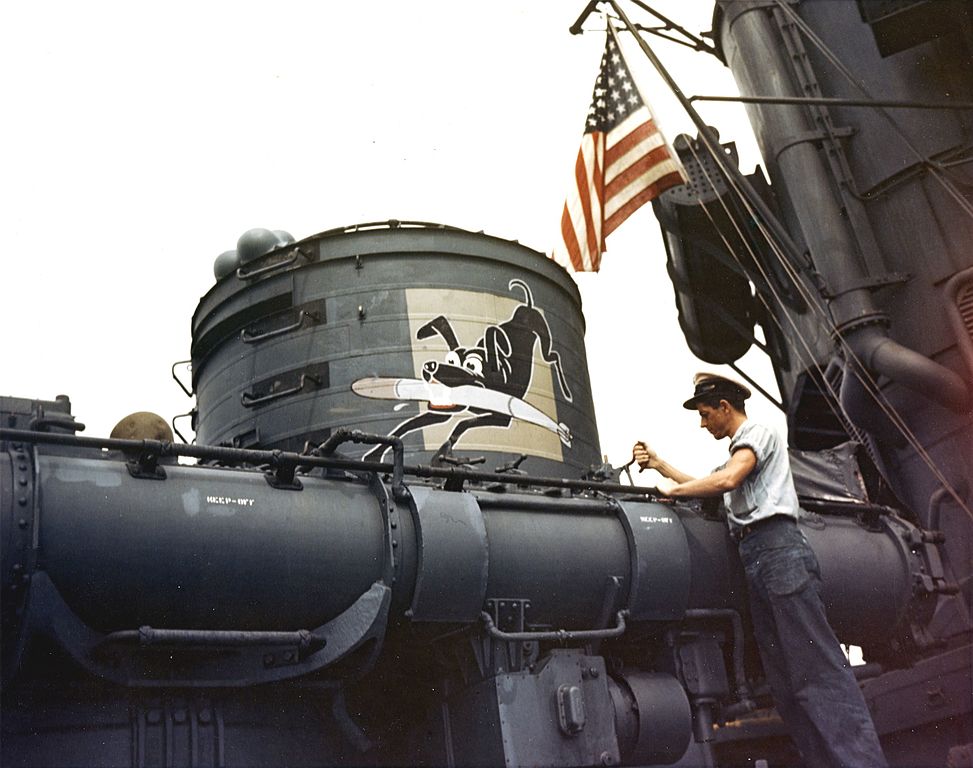
 Latest Facebook Entry -
Latest Facebook Entry -  X(Tweeter) Naval Encyclopedia's deck archive
X(Tweeter) Naval Encyclopedia's deck archive Instagram (@navalencyc)
Instagram (@navalencyc)





 French Navy
French Navy Royal Navy
Royal Navy Russian Navy
Russian Navy Armada Espanola
Armada Espanola Austrian Navy
Austrian Navy K.u.K. Kriegsmarine
K.u.K. Kriegsmarine Dansk Marine
Dansk Marine Nautiko Hellenon
Nautiko Hellenon Koninklije Marine 1870
Koninklije Marine 1870 Marinha do Brasil
Marinha do Brasil Osmanlı Donanması
Osmanlı Donanması Marina Do Peru
Marina Do Peru Marinha do Portugal
Marinha do Portugal Regia Marina 1870
Regia Marina 1870 Nihhon Kaigun 1870
Nihhon Kaigun 1870 Preußische Marine 1870
Preußische Marine 1870 Russkiy Flot 1870
Russkiy Flot 1870 Svenska marinen
Svenska marinen Søværnet
Søværnet Union Navy
Union Navy Confederate Navy
Confederate Navy Armada de Argentina
Armada de Argentina Imperial Chinese Navy
Imperial Chinese Navy Marinha do Portugal
Marinha do Portugal Mexico
Mexico Kaiserliche Marine
Kaiserliche Marine 1898 US Navy
1898 US Navy Sovietskiy Flot
Sovietskiy Flot Royal Canadian Navy
Royal Canadian Navy Royal Australian Navy
Royal Australian Navy RNZN Fleet
RNZN Fleet Chinese Navy 1937
Chinese Navy 1937 Kriegsmarine
Kriegsmarine Chilean Navy
Chilean Navy Danish Navy
Danish Navy Finnish Navy
Finnish Navy Hellenic Navy
Hellenic Navy Polish Navy
Polish Navy Romanian Navy
Romanian Navy Turkish Navy
Turkish Navy Royal Yugoslav Navy
Royal Yugoslav Navy Royal Thai Navy
Royal Thai Navy Minor Navies
Minor Navies Albania
Albania Austria
Austria Belgium
Belgium Columbia
Columbia Costa Rica
Costa Rica Cuba
Cuba Czechoslovakia
Czechoslovakia Dominican Republic
Dominican Republic Haiti
Haiti Hungary
Hungary Honduras
Honduras Estonia
Estonia Iceland
Iceland Eire
Eire Equador
Equador Iran
Iran Iraq
Iraq Latvia
Latvia Liberia
Liberia Lithuania
Lithuania Mandchukuo
Mandchukuo Morocco
Morocco Nicaragua
Nicaragua Persia
Persia San Salvador
San Salvador Sarawak
Sarawak Uruguay
Uruguay Venezuela
Venezuela Zanzibar
Zanzibar Warsaw Pact Navies
Warsaw Pact Navies Bulgaria
Bulgaria Hungary
Hungary

 Bundesmarine
Bundesmarine Dutch Navy
Dutch Navy Hellenic Navy
Hellenic Navy Marina Militare
Marina Militare Yugoslav Navy
Yugoslav Navy Chinese Navy
Chinese Navy Indian Navy
Indian Navy Indonesian Navy
Indonesian Navy JMSDF
JMSDF North Korean Navy
North Korean Navy Pakistani Navy
Pakistani Navy Philippines Navy
Philippines Navy ROKN
ROKN Rep. of Singapore Navy
Rep. of Singapore Navy Taiwanese Navy
Taiwanese Navy IDF Navy
IDF Navy Saudi Navy
Saudi Navy Royal New Zealand Navy
Royal New Zealand Navy Egyptian Navy
Egyptian Navy South African Navy
South African Navy






























 Ukrainian Navy
Ukrainian Navy dbodesign
dbodesign